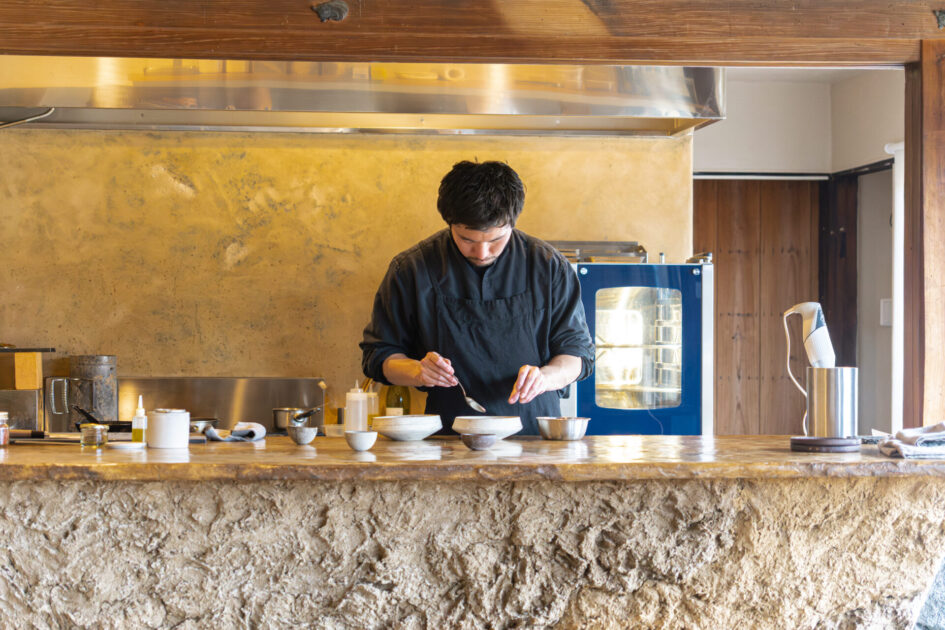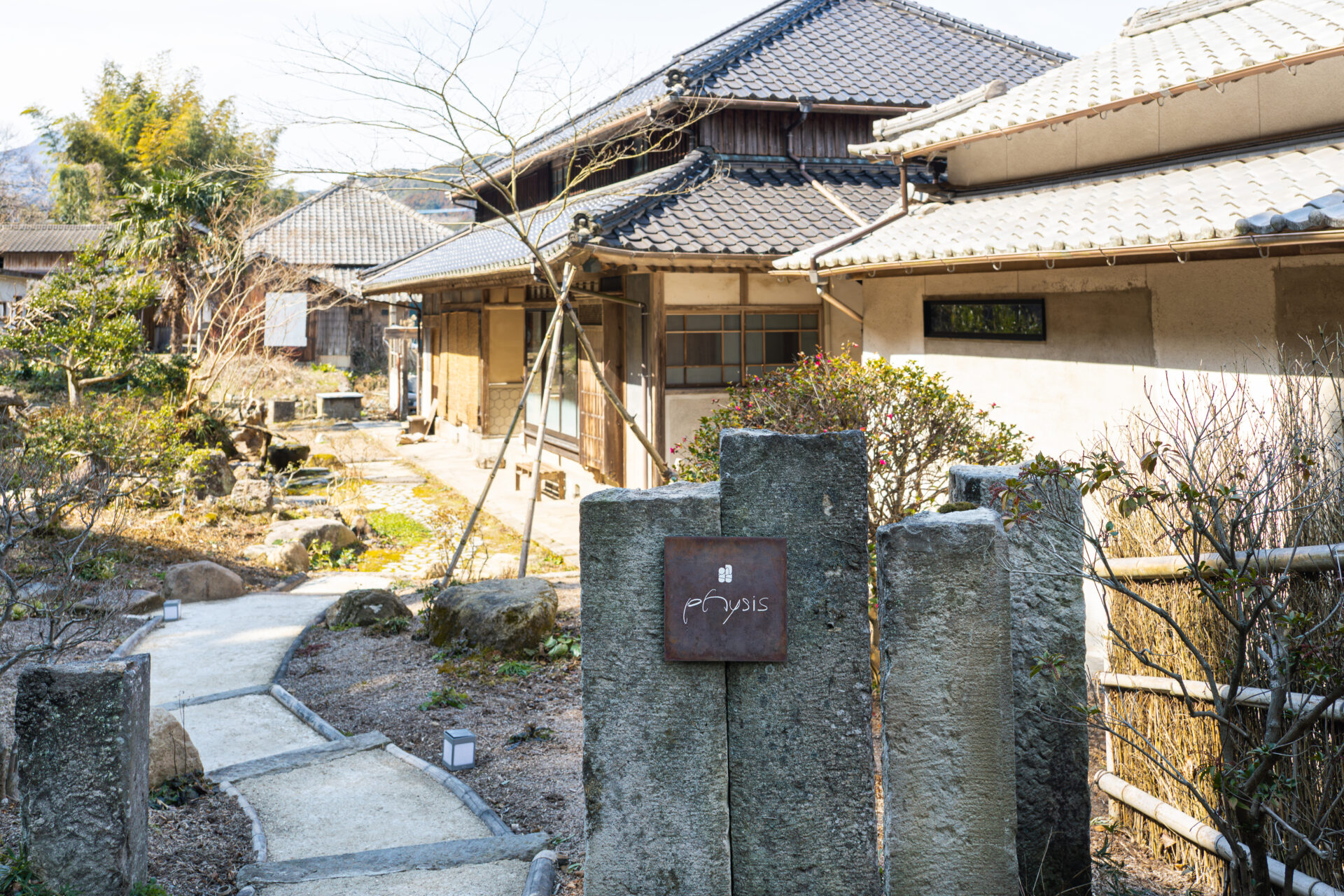
CONTENTS
About physis
Concept
physis is a Greek word that means “the inherent nature of things,” or more precisely, “nature as it is, unaltered.” It refers not simply to nature in general, but to its essential and universal state—free from human interference.
At physis, this philosophy is reflected in both the cuisine and the space. Ingredients sourced from the local Kunisaki region are used in their natural form, showcasing the unique climate and culture of the land. The restaurant itself is housed in a renovated traditional Japanese home that is over 100 years old. Rather than being heavily decorated, the interior honors natural beauty with a minimalist and respectful design.
Guests are invited to enjoy a special dining experience that engages all five senses—with dishes that highlight the true flavors of seasonal ingredients and a setting that immerses them in the ever-changing landscapes of Japan’s four seasons. Dining at physis is truly a moment to connect with “the inherent nature of things.”
Chef Ryōhei Kawasaki
Chef Ryōhei Kawasaki hails from Hiroshima Prefecture. After honing his skills at bistros in Tokyo, he moved to the Alsace region of France for further training. He later worked at the one-Michelin-starred restaurant QUI PLUME LA LUNE in Paris, where he mastered refined French culinary techniques.
Upon returning to Japan, he traveled across the country, including his native Hiroshima, in search of the right place to open his own restaurant. He was deeply drawn to the rich natural environment and distinctive culture of Kunisaki, Ōita, and ultimately decided to relocate there. Today, he operates the auberge-style restaurant physis in Kunisaki.
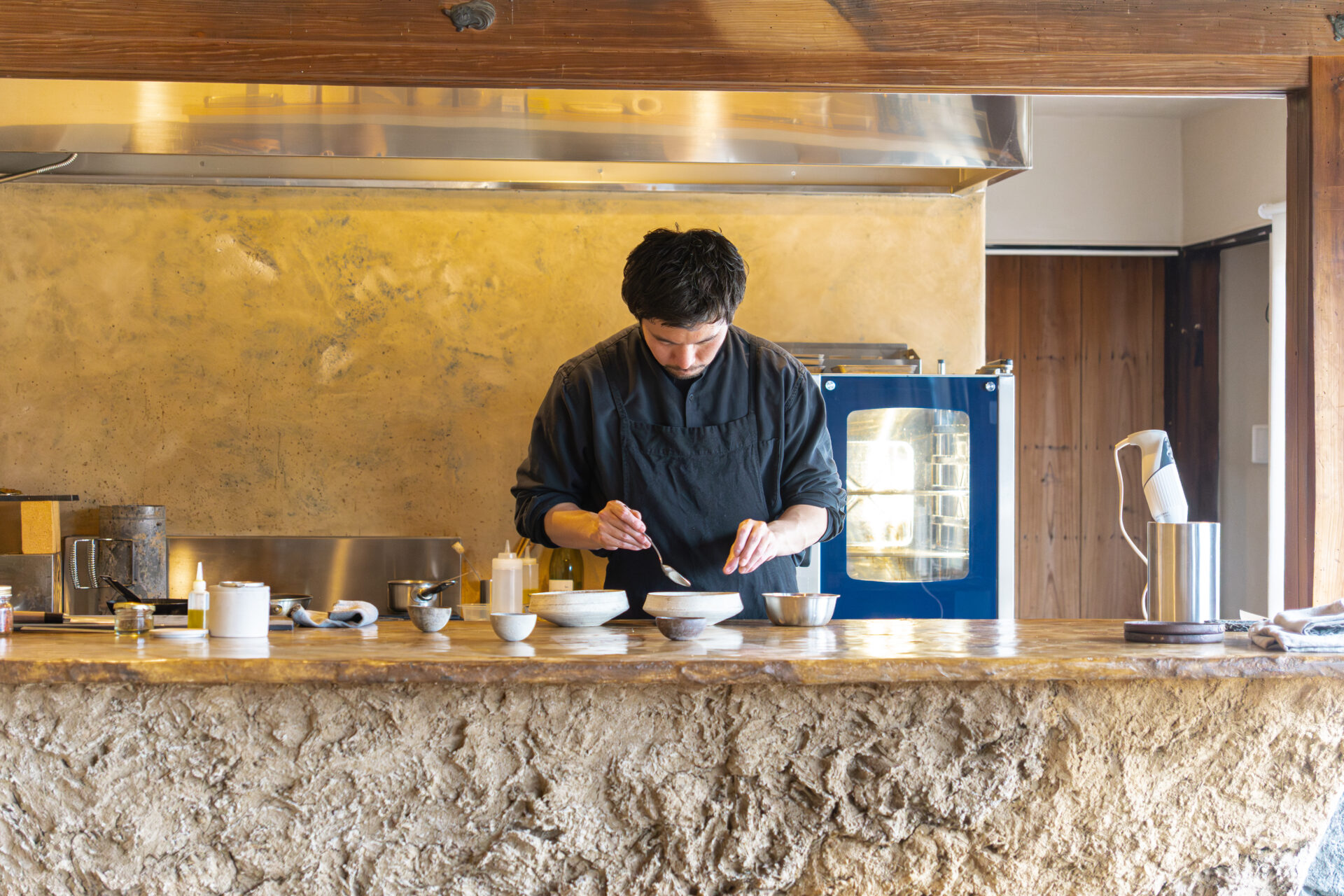
Restaurant Acclaim
Housed in a beautifully renovated 100-year-old kominka (traditional Japanese house), physis offers diners the opportunity to enjoy Chef Kawasaki’s delicate and expressive cuisine. The menu changes with the seasons, highlighting the freshest local ingredients at their peak.
Though still a relatively new establishment, physis is already generating buzz among gourmands from across Japan. As word continues to spread, it is expected to grow in reputation. The evolution of physis in the serene setting of Kunisaki is something to look forward to.
Dining Prelude
Exterior & Entrance
The exterior of physis preserves the charm of a traditional Japanese house. Thoughtfully renovated, the over-100-year-old building offers a tranquil and welcoming atmosphere for guests.
A stone-paved path winds through the garden, surrounded by curated greenery that softly welcomes visitors. Nestled against a mountainous backdrop, the setting offers a peaceful escape from the hustle and bustle of urban life.
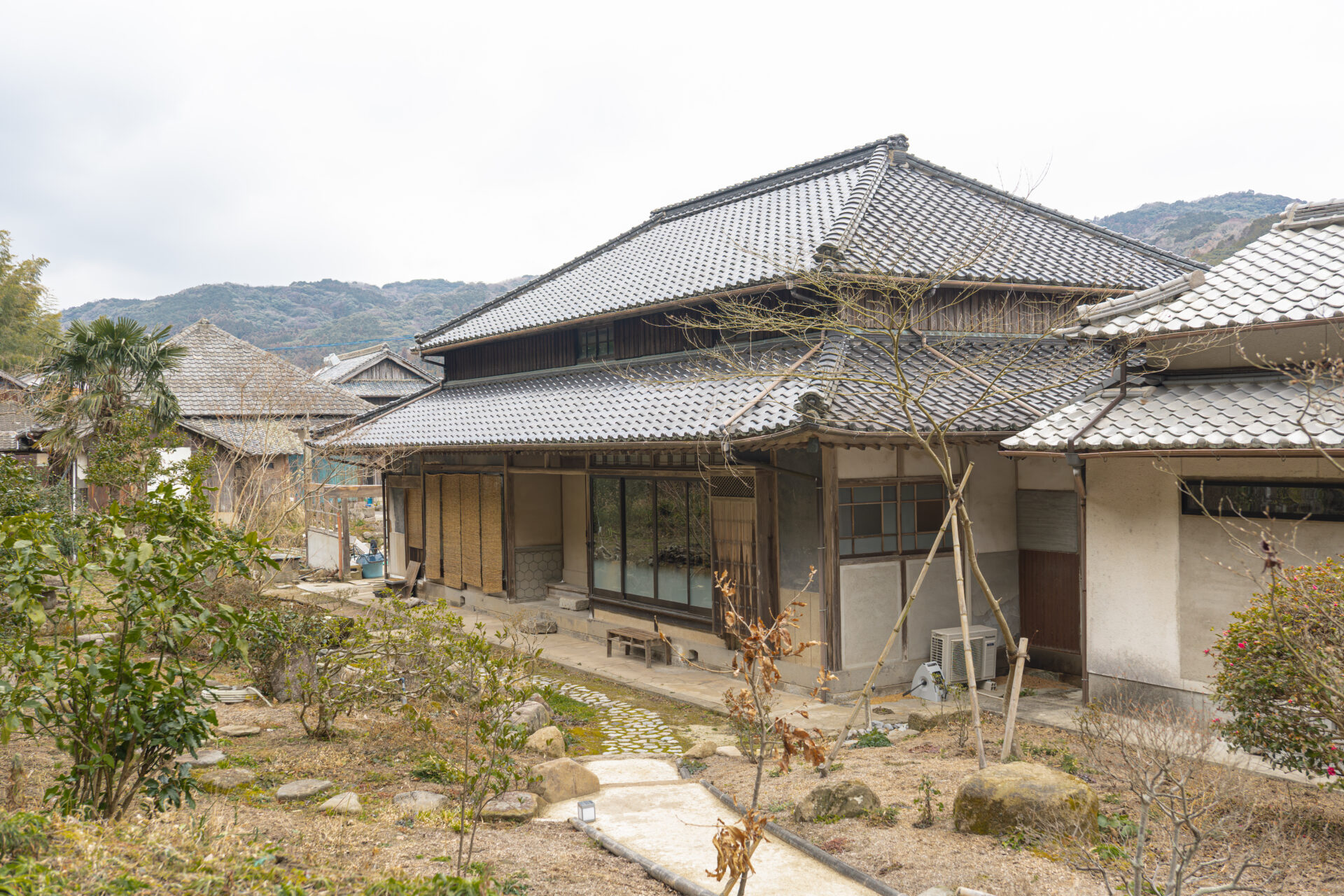
Dining Space
The interior of physis merges the character of a traditional Japanese kominka with a modern, refined aesthetic.
Large windows frame seasonal views of the surrounding landscape—like a living painting of rice fields and mountain ridges. The space invites diners to relax and savor the passage of time.
Natural solid wood is used for the floors and beams, adding warmth to the atmosphere. The tables and chairs feature a clean, elegant design that harmonizes with the cuisine.
Each table is set with understated elegance—black iron plates paired with natural linen napkins. The aesthetic strikes a balance between the refined beauty of French cuisine and the serene calm of traditional Japanese design.
A notable feature is the irori (traditional sunken hearth), which adds a touch of rustic authenticity while blending seamlessly with a contemporary minimalist sensibility. Walls are finished with natural materials, enhancing the space’s quiet and grounded atmosphere.
At the open kitchen, guests can watch Chef Kawasaki meticulously prepare each dish. The counter area features earthy textures reminiscent of earthen walls, tying the design further to the surrounding natural environment.
At physis, only one party is served per day, with a maximum of six guests. This private dining format offers a luxurious and intimate culinary experience. The peaceful surroundings allow for unrushed conversation and connection over an exceptional meal.
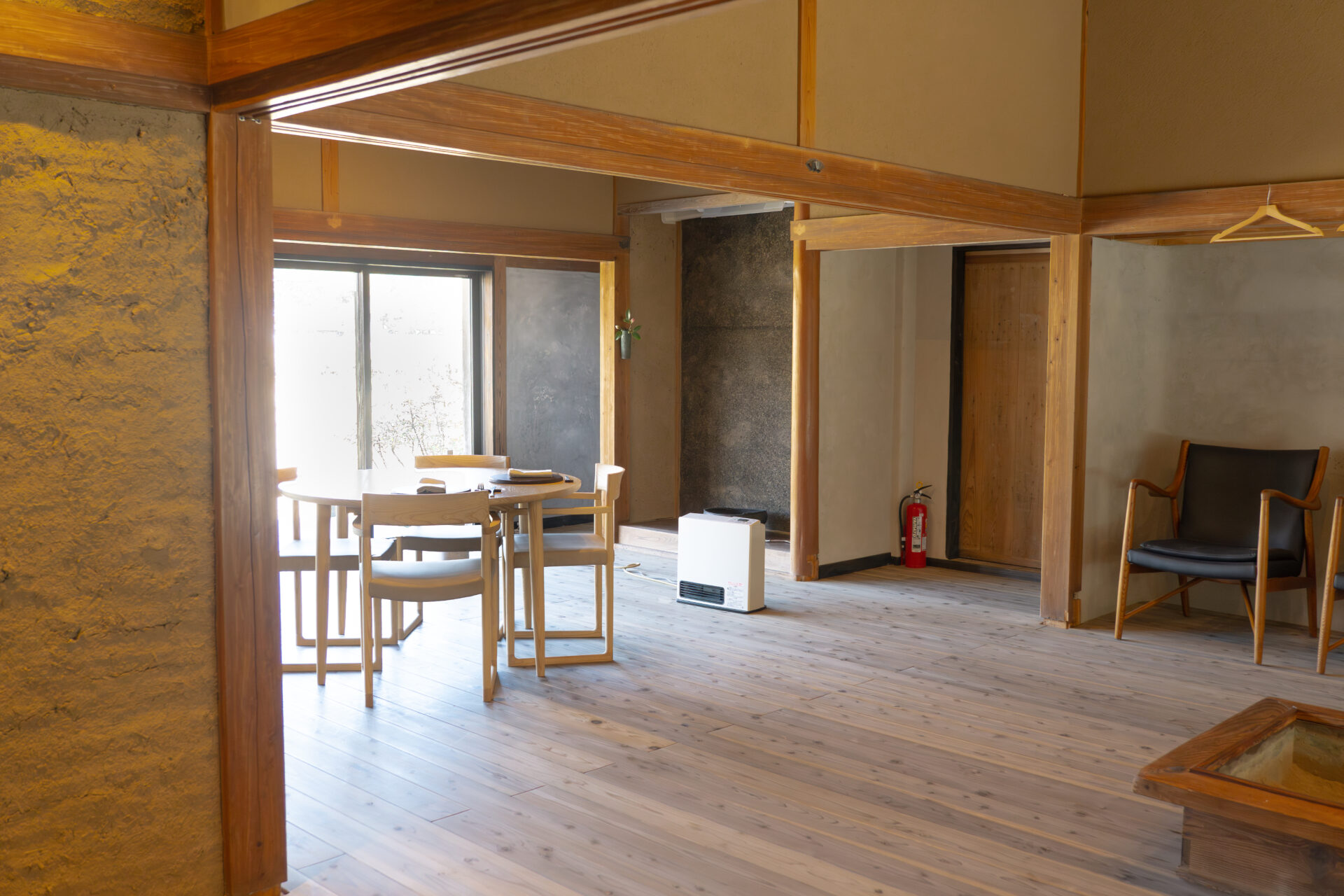
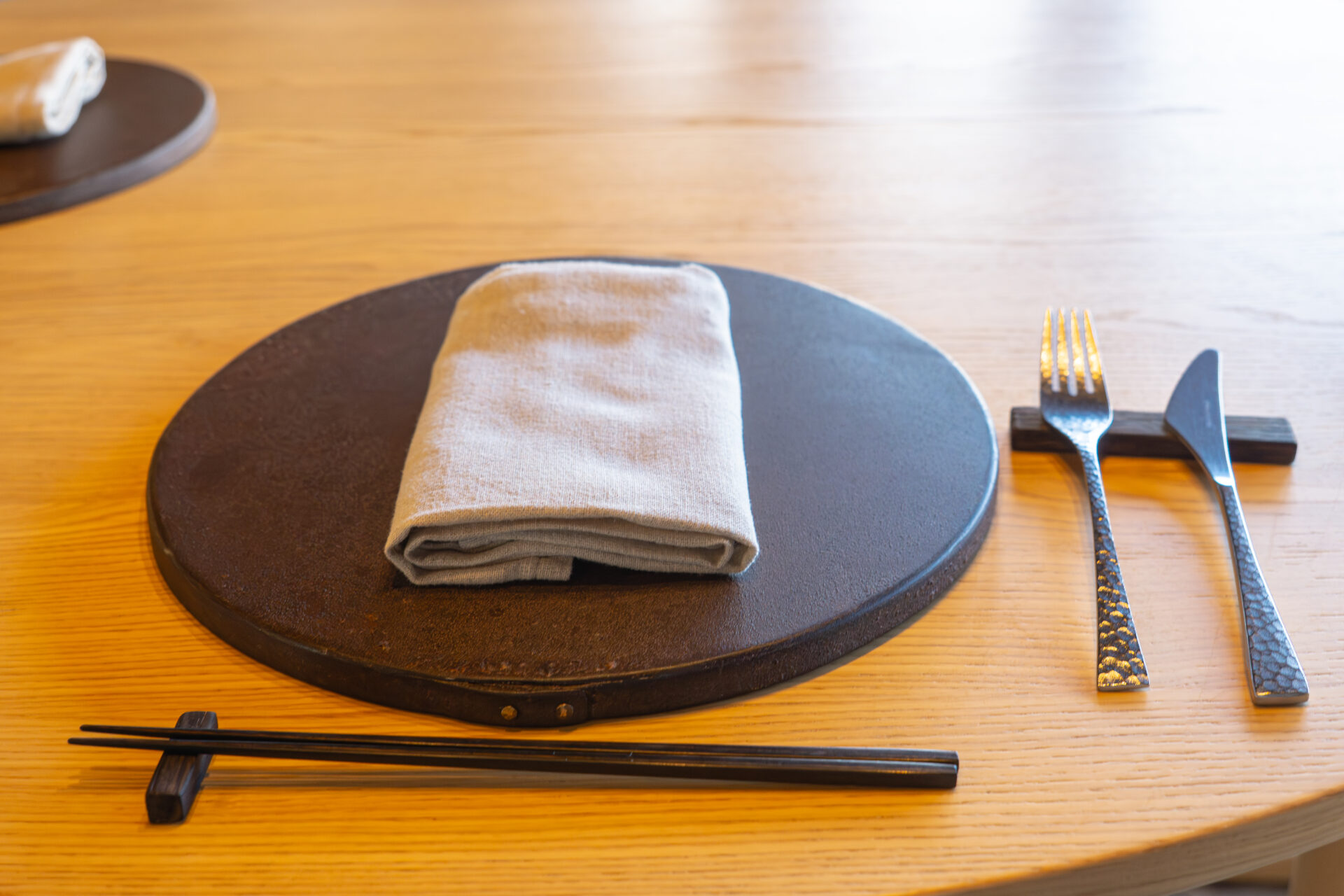
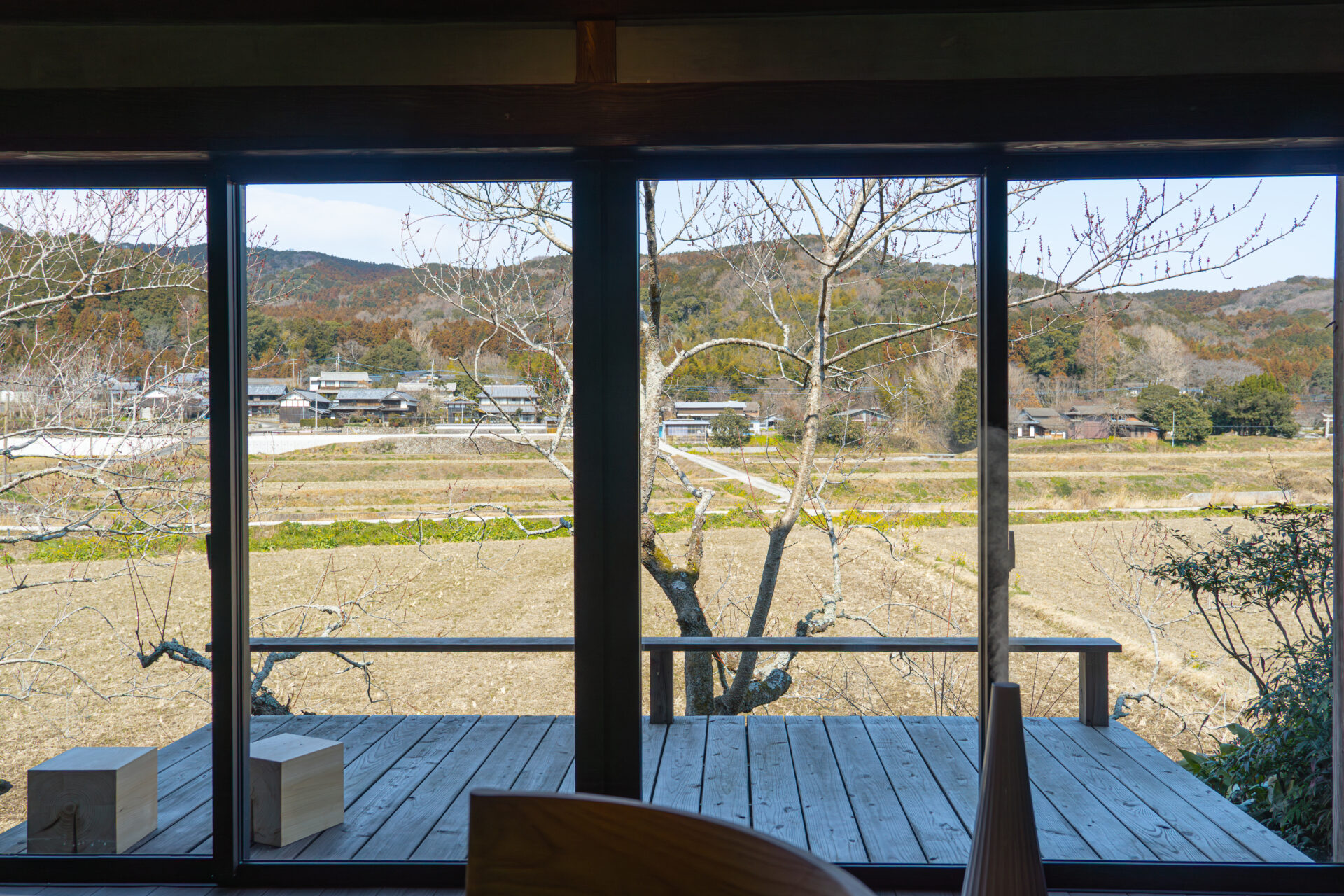
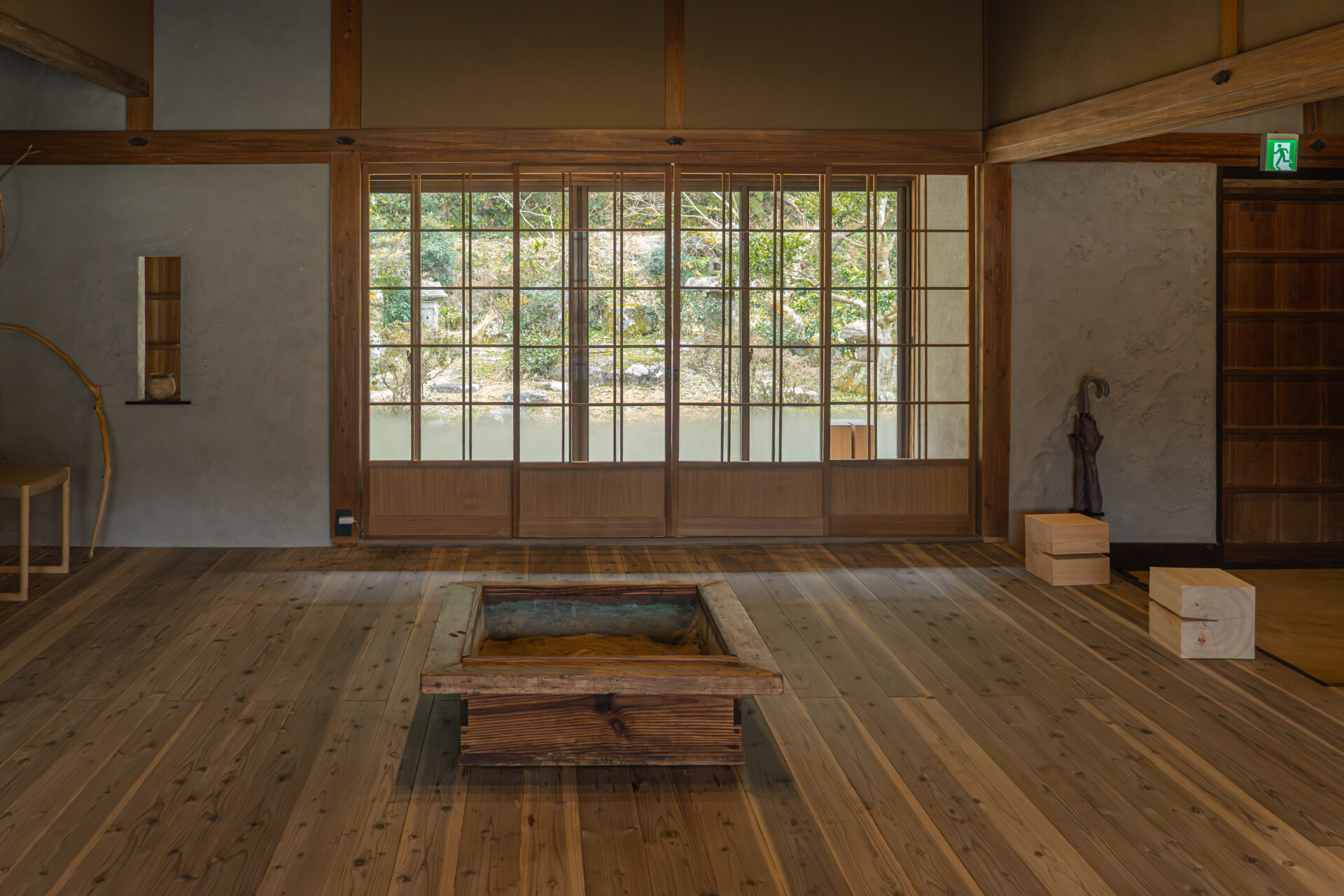
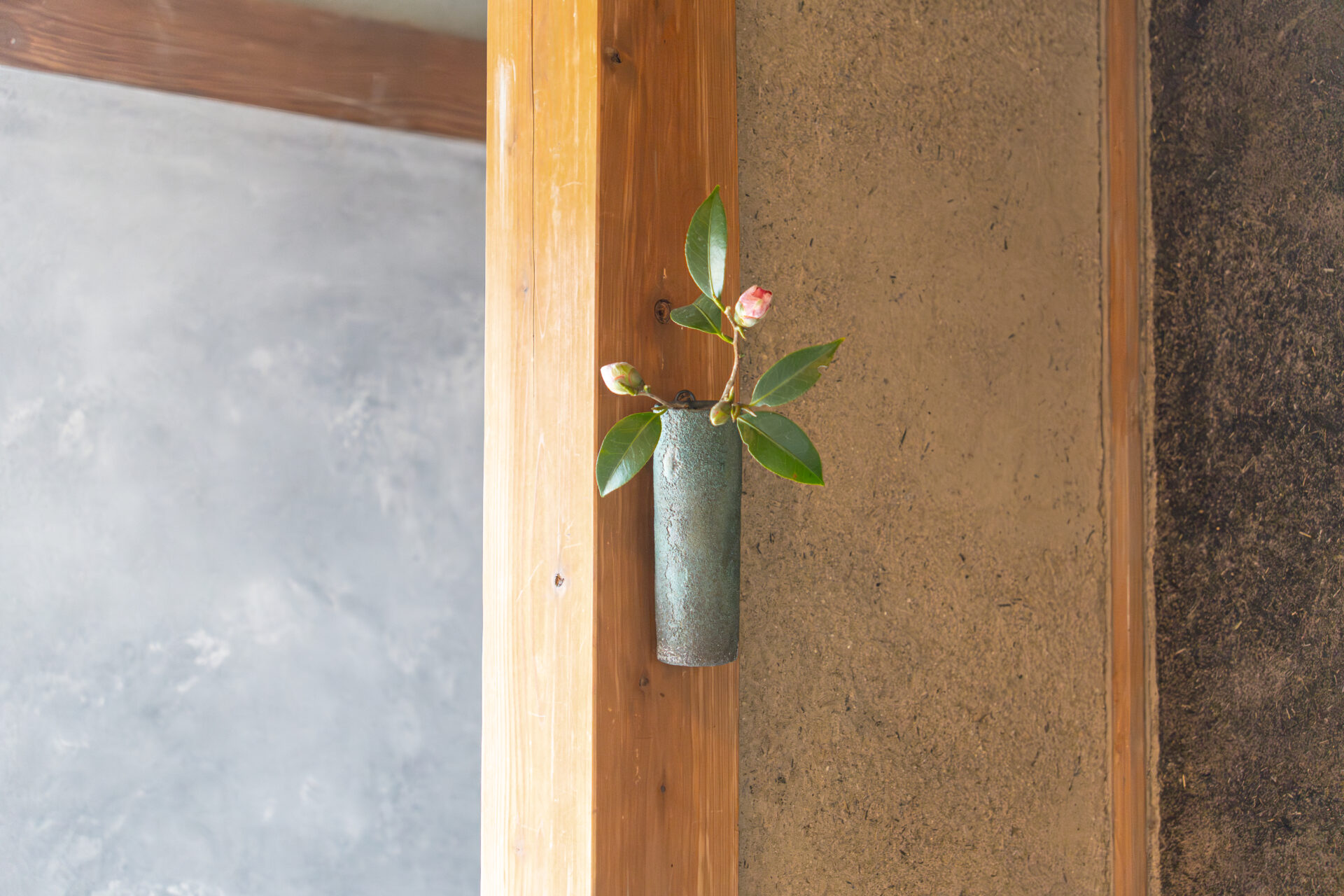
Menu Presentation
The menu is elegantly wrapped in a simply folded piece of paper. When opened, it reveals the courses in a refined typeface, with carefully considered spacing that conveys a sense of sophistication.
Each course is not just listed by name, but also paired with its primary ingredients in a contrasting layout—for example, “Ark Shell × Rapeseed Blossoms” or “Venison × Burdock.” This invites curiosity and anticipation, hinting at the creativity and harmony of each pairing.
Opening the menu marks a special, ceremonial moment—the true beginning of the meal. The tactile experience of unfolding the paper enhances the sense of immersion in the culinary journey ahead.
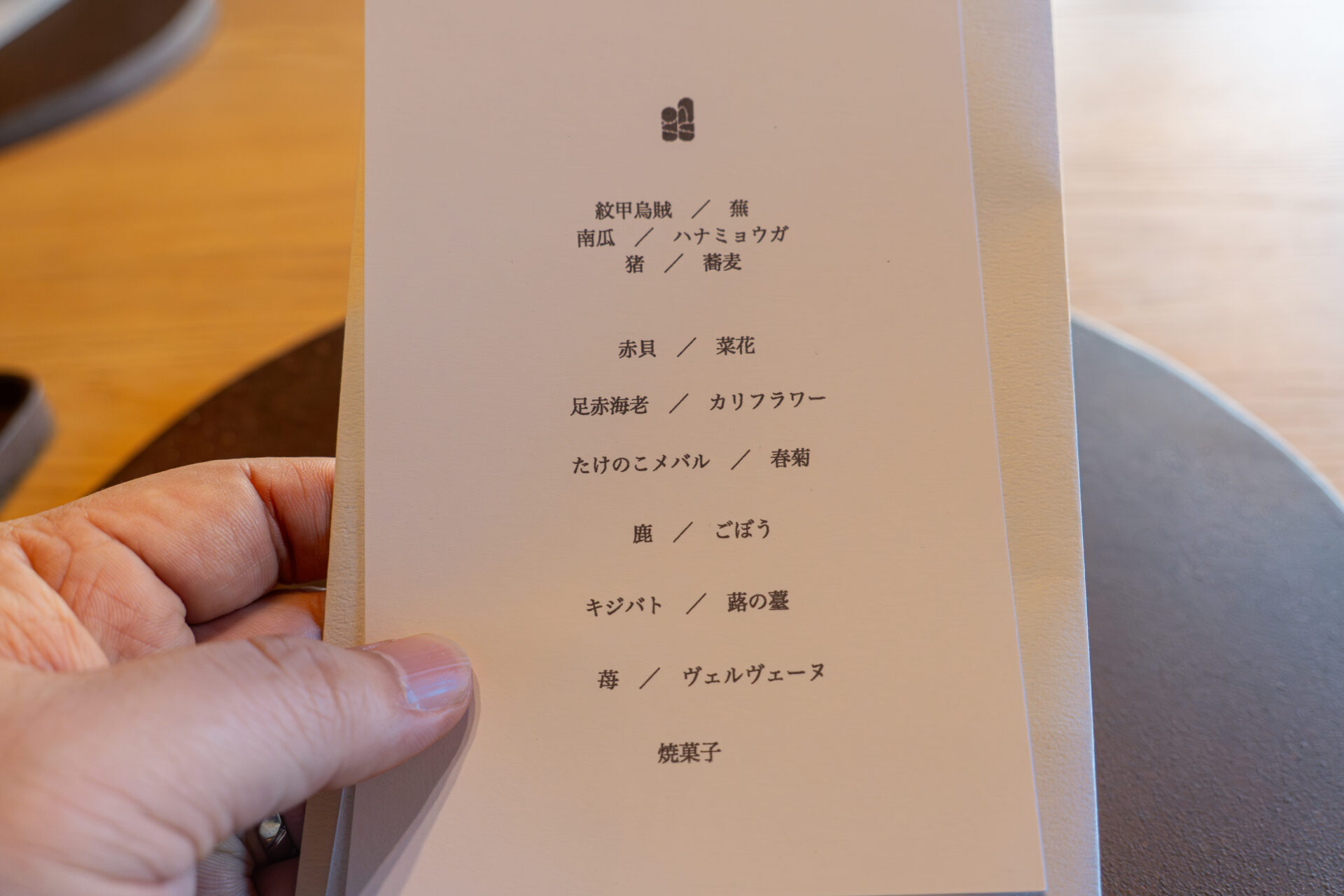
Starter Drink
To begin the meal, guests are offered a refreshing soda made with homemade syrup from ume (Japanese plums) harvested in the local Kunoura area. The natural sweetness and bright acidity of the plum, combined with lively carbonation, cleanse the palate and provide a refreshing prelude to the courses that follow.
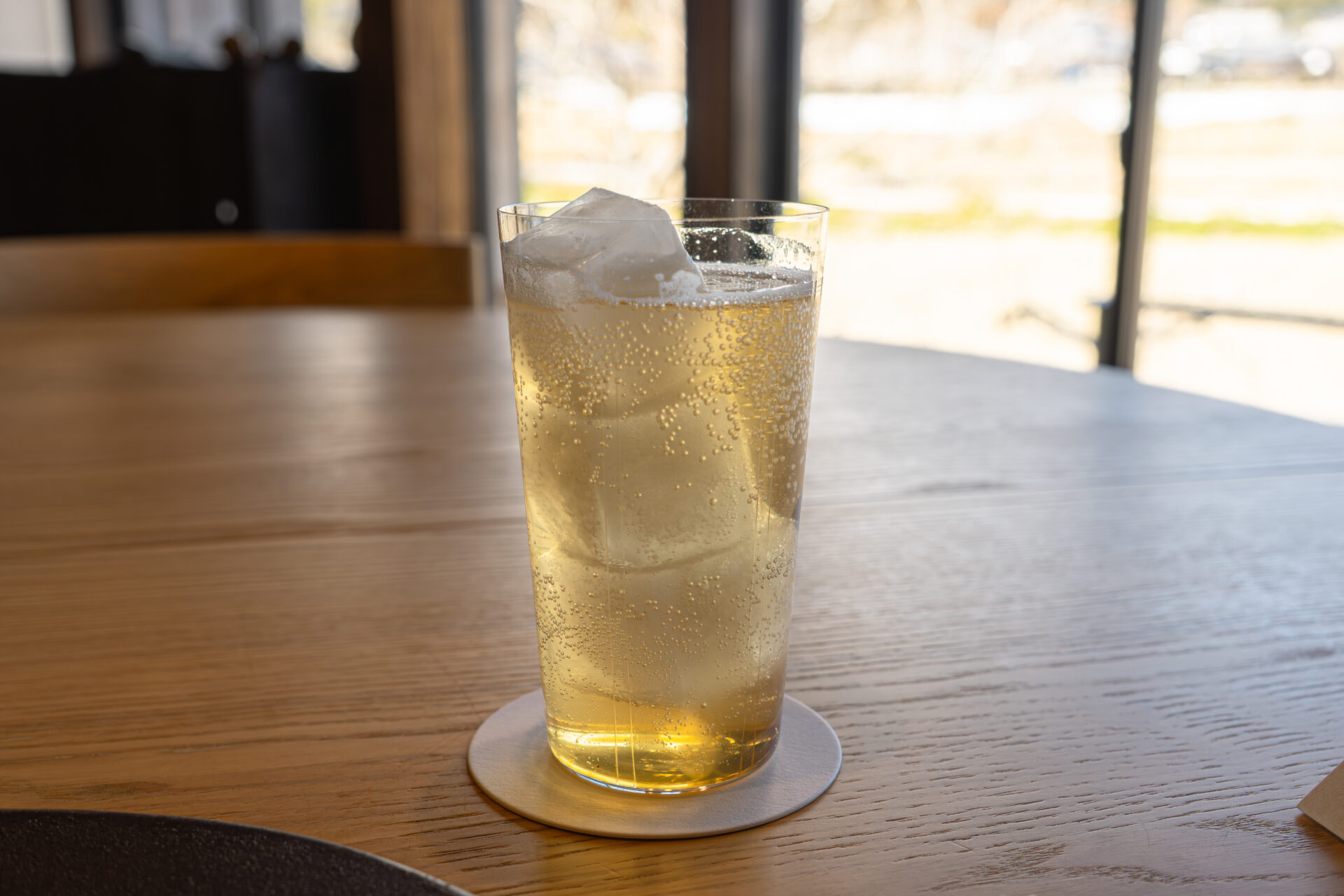
Dishes Experienced
Bigfin Reef Squid / Turnip
The first course was a delicate tart featuring bigfin reef squid and turnip. Inside a crisp and light tart shell was tender squid, topped beautifully with thinly sliced turnip arranged in graceful layers.
To finish, finely grated citrus zest added a refreshing aroma and a gentle acidity that brightened the dish. The umami of the squid, the sweetness of the turnip, and the citrusy fragrance came together in harmony—each bite unfolding with refined subtlety.
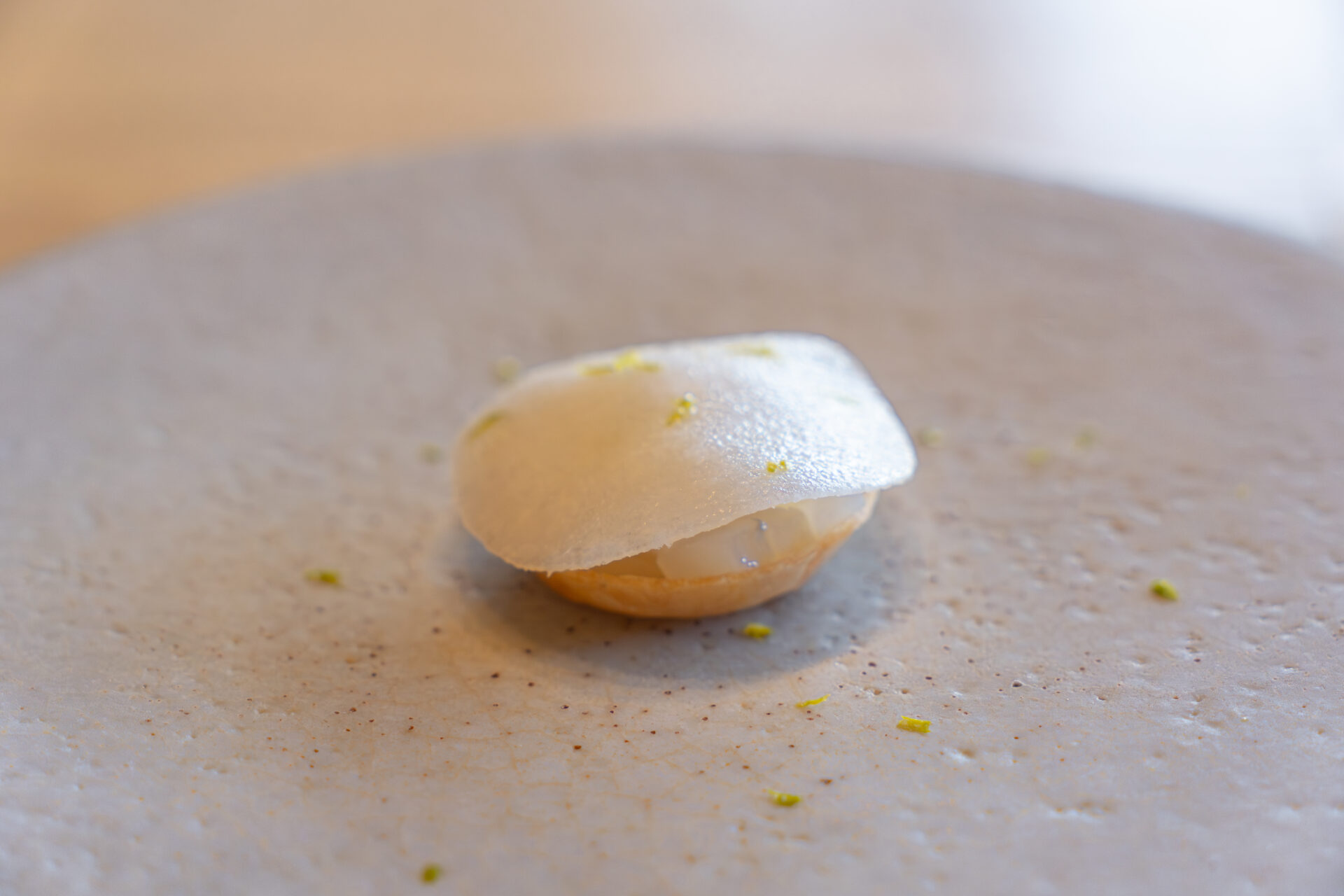
Pumpkin / Wild Myoga Flower
This smooth and velvety pumpkin soup delivered a rich yet gentle sweetness.
It was topped with a delicate foam infused with the aromatic seeds of wild myoga flower foraged from the surrounding mountains.
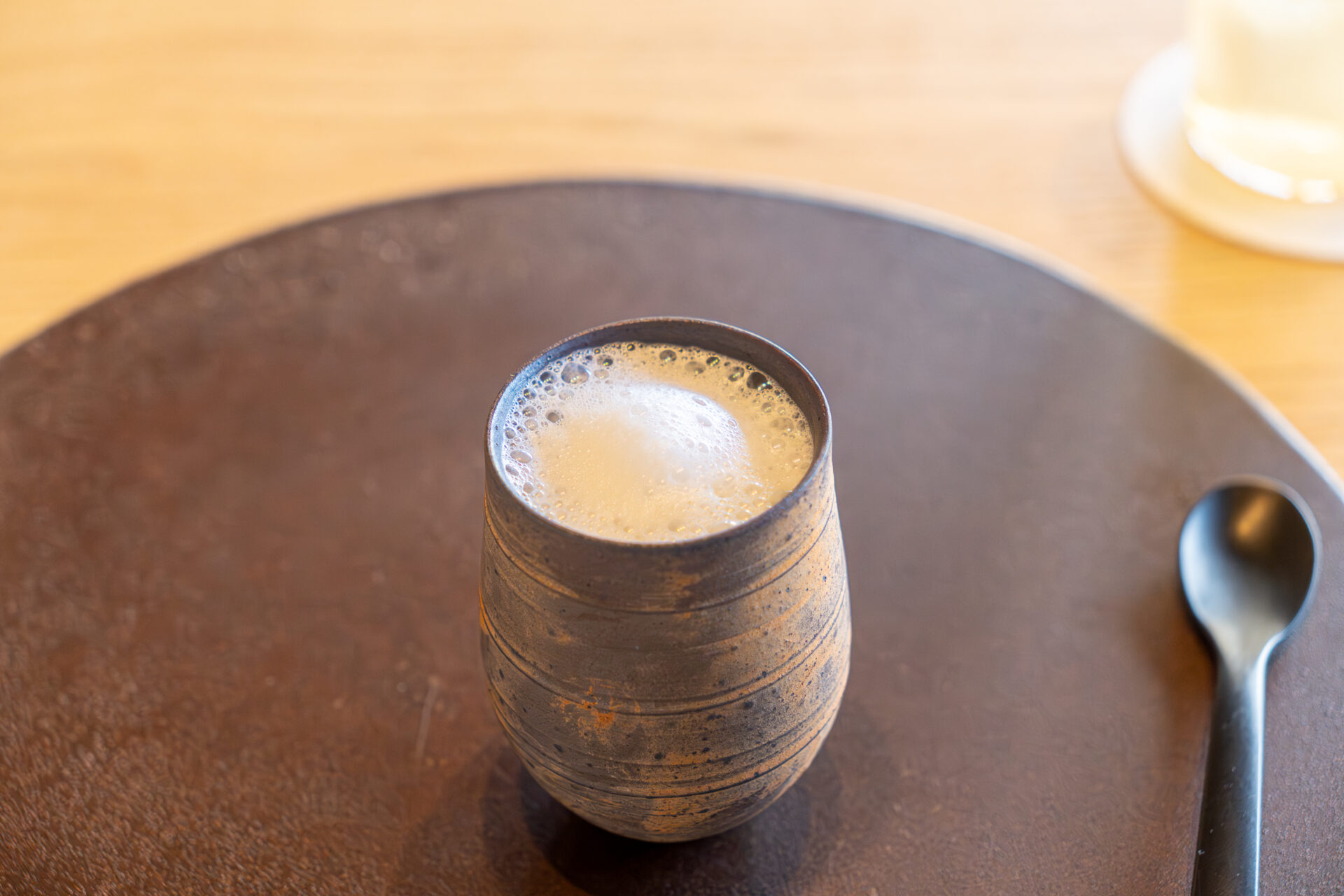
The airy foam gently blanketed the soup, and with each spoonful, its fragrance softly expanded, pairing exquisitely with the pumpkin’s sweetness. A deceptively simple dish that celebrated the power of the ingredients, lingering with natural depth and elegance.
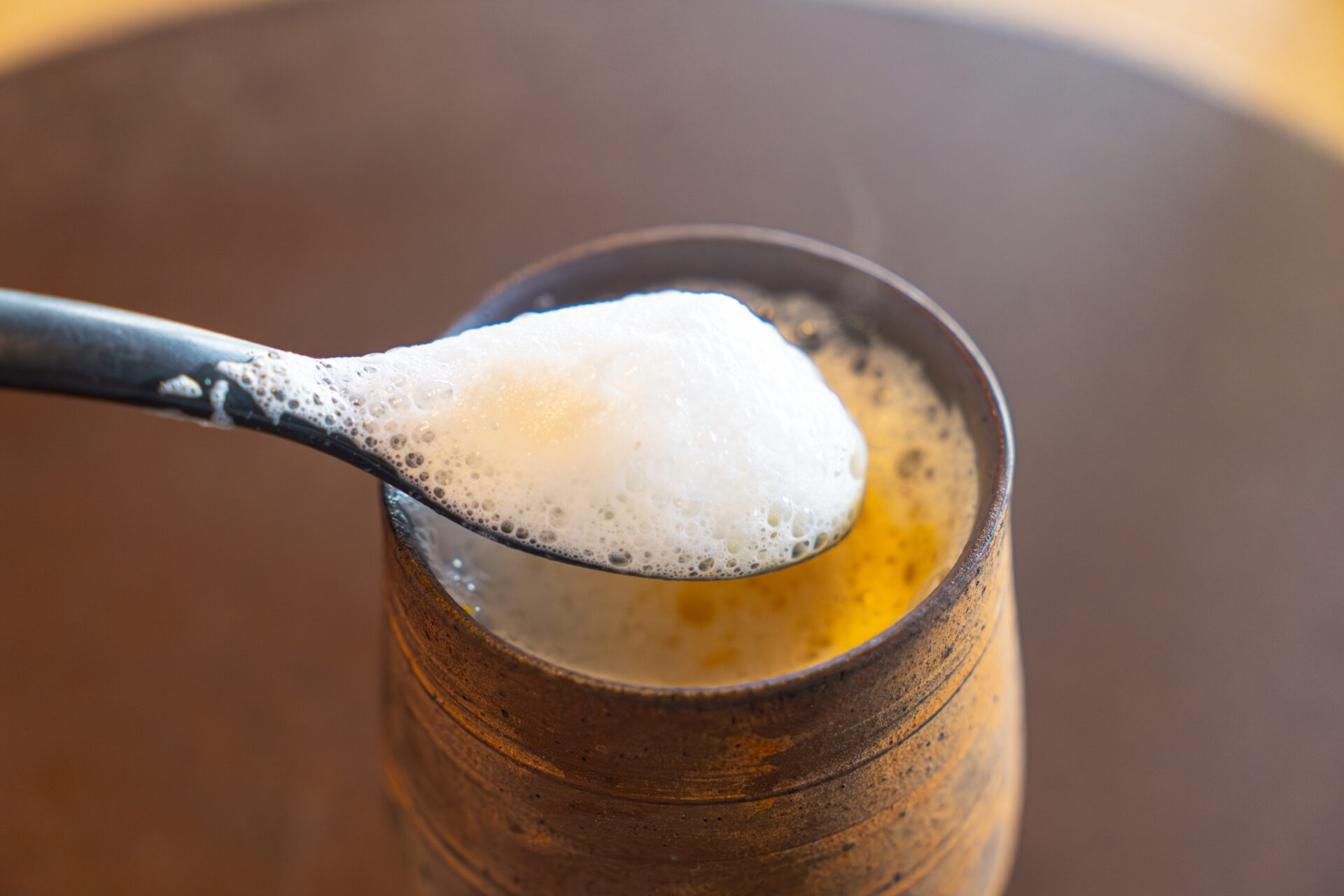
Wild Boar / Buckwheat
A galette made with buckwheat flour, filled with richly flavorful wild boar and creamy gingko nuts.
The robust taste of the wild boar was perfectly complemented by the mellow, nutty softness of the gingko. Around the plate, powdered sansho pepper and mustard—both toasted to intensify their aromas—added a subtle, spicy complexity that elevated the dish.
As you chew, the textures and aromas shift and overlap, showcasing the individuality of each ingredient.
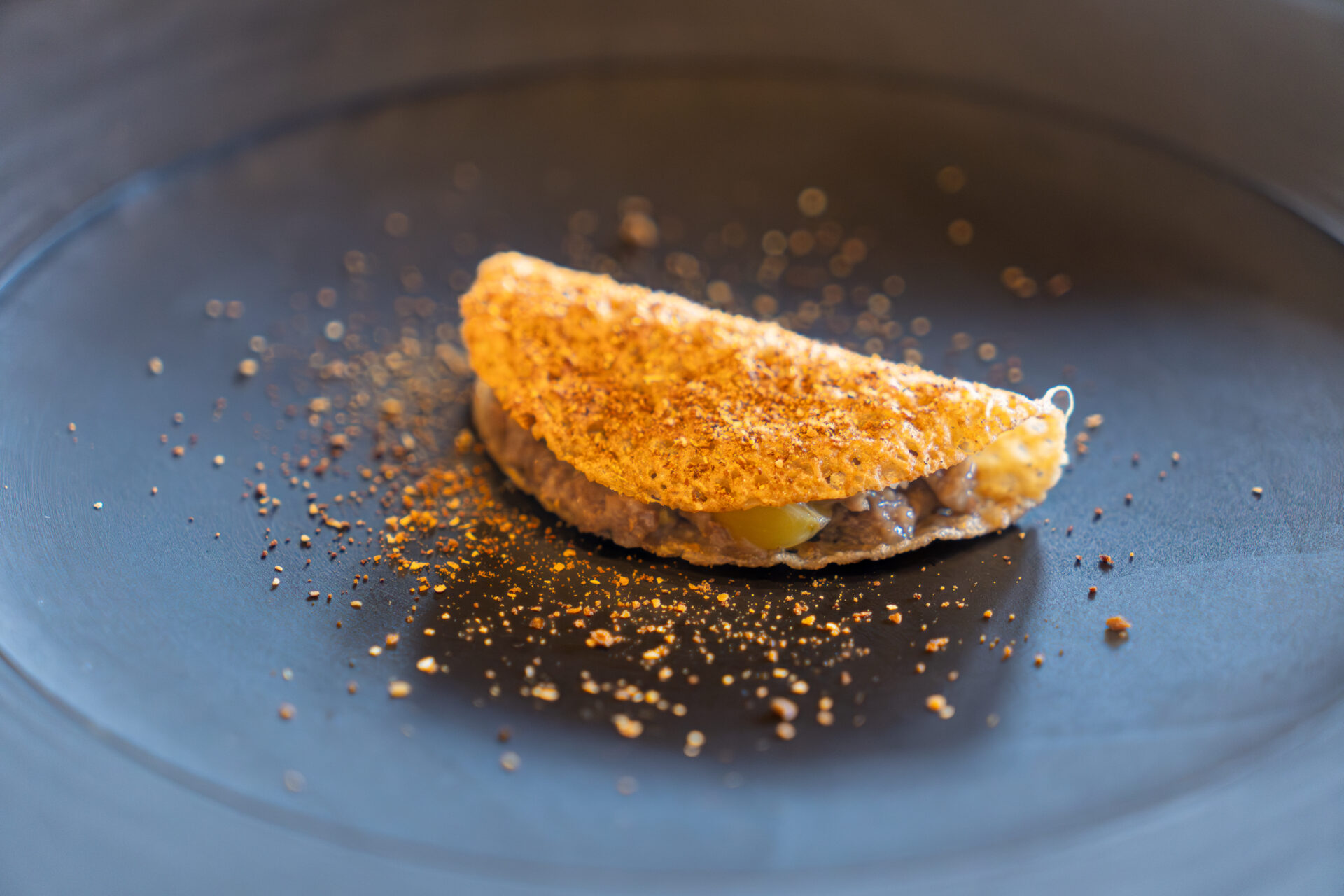
Ark Shell / Rapeseed Blossoms
A refreshing salad of ark shell with cabbage, nanohana (rapeseed blossoms), and snap peas.
The ark shell provided a rich umami and a pleasantly firm, almost crunchy texture. This contrasted beautifully with the crispness of the vegetables. The slight bitterness of the nanohana, the sweetness of the snap peas, and the gentle bite of the cabbage harmonized with the shellfish, creating layered flavors in every bite.
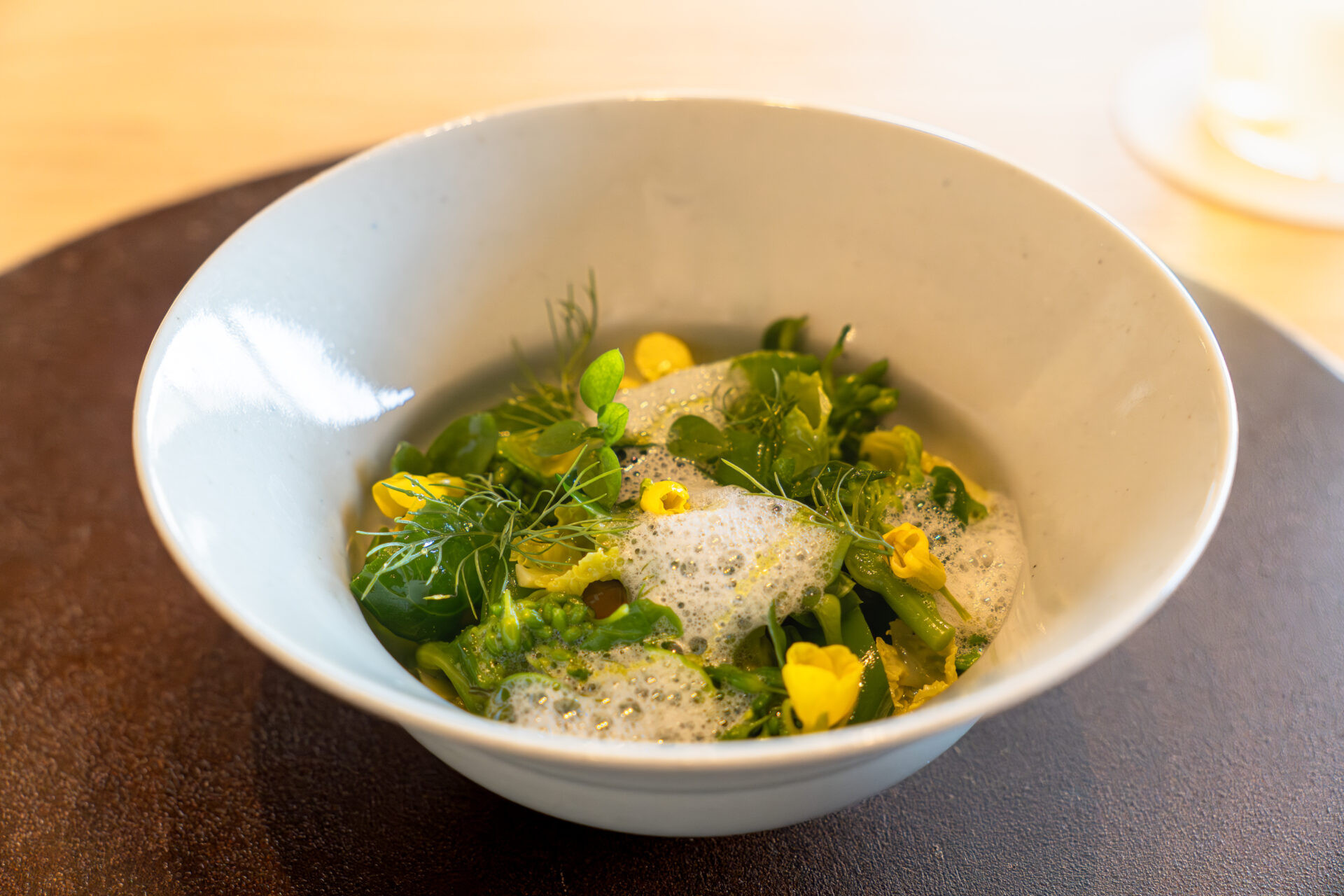
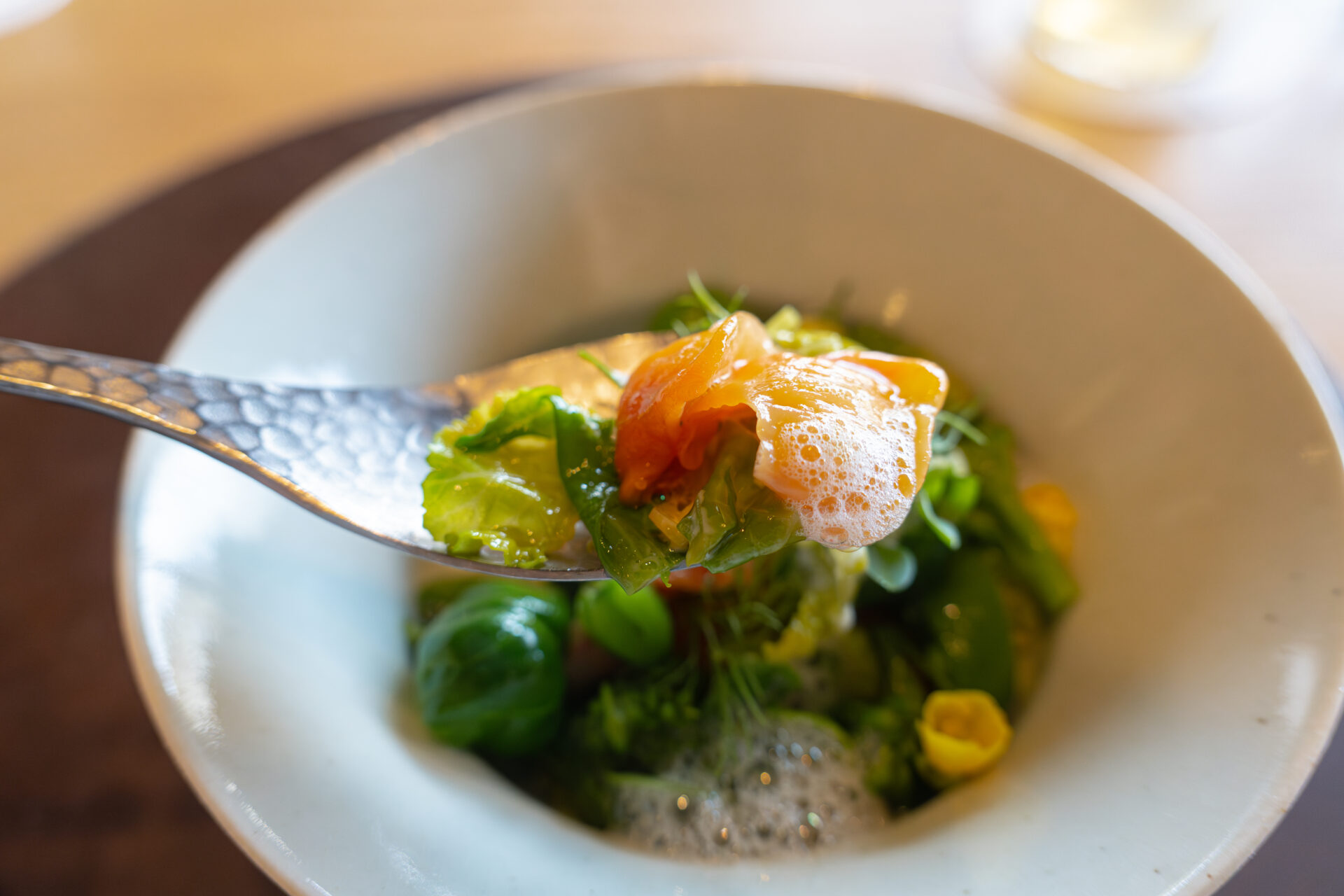
Japanese Red Prawn / Cauliflower
A dish highlighting the gentle sweetness of Japanese red prawn (ashiaka ebi) and the subtle flavor of cauliflower.
The base was a smooth cauliflower sauce, topped with sautéed, sliced cauliflower to create a contrast of textures.
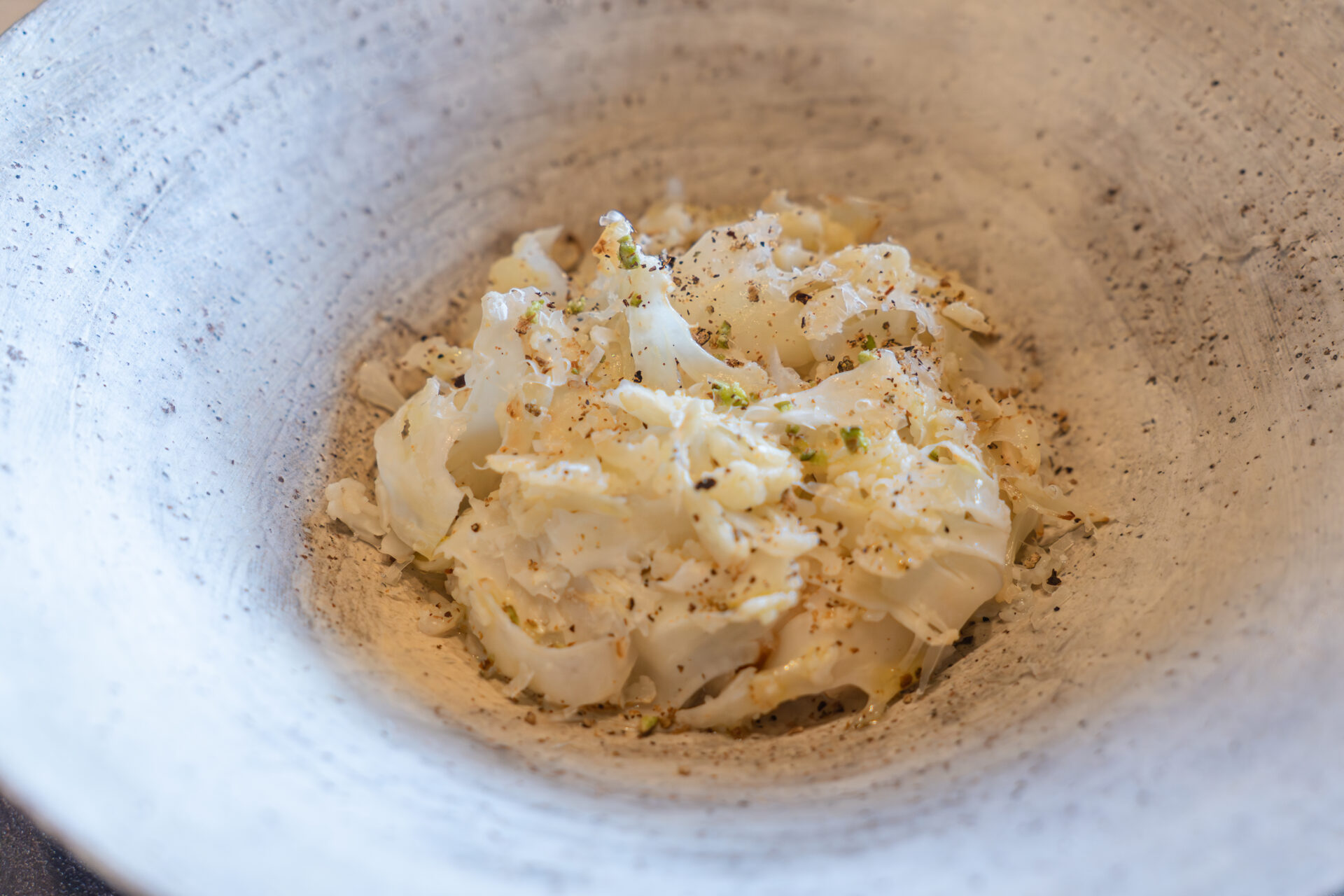
Juniper berries were used to add a faintly spicy, aromatic accent. The creamy mouthfeel of both the prawn and cauliflower slowly expanded on the palate, leaving a lingering impression.

Bread was provided by HIBINO, a bakery in Bungotakada City, specializing in naturally leavened bread made from domestic wheat. Each bite conveyed a deep respect for ingredients and craftsmanship.
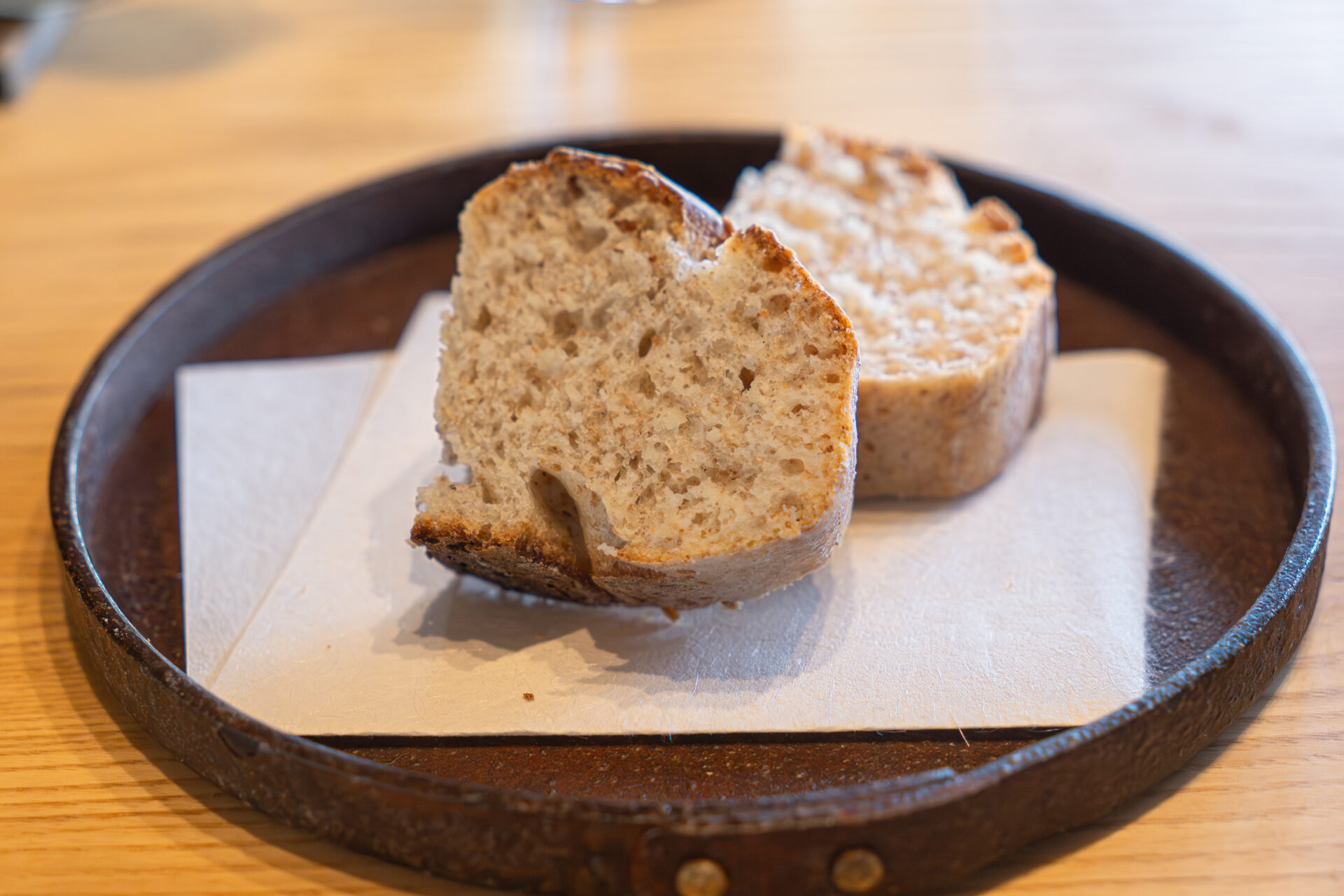
Rockfish / Garland Chrysanthemum
This course featured tender fillet of takenoko mebaru (rockfish), accompanied by a sauce made from fish stock, raw seaweed, and garland chrysanthemum (shungiku).
The umami of the seaweed and the slight bitterness of the chrysanthemum enveloped the delicate flavor of the rockfish, creating a dish full of depth.
The addition of katsuo-na (a type of mustard green) and edible wild plants provided textural contrast and a finishing touch of balance. A soul-warming dish that celebrated the harmony of seasonal ingredients.
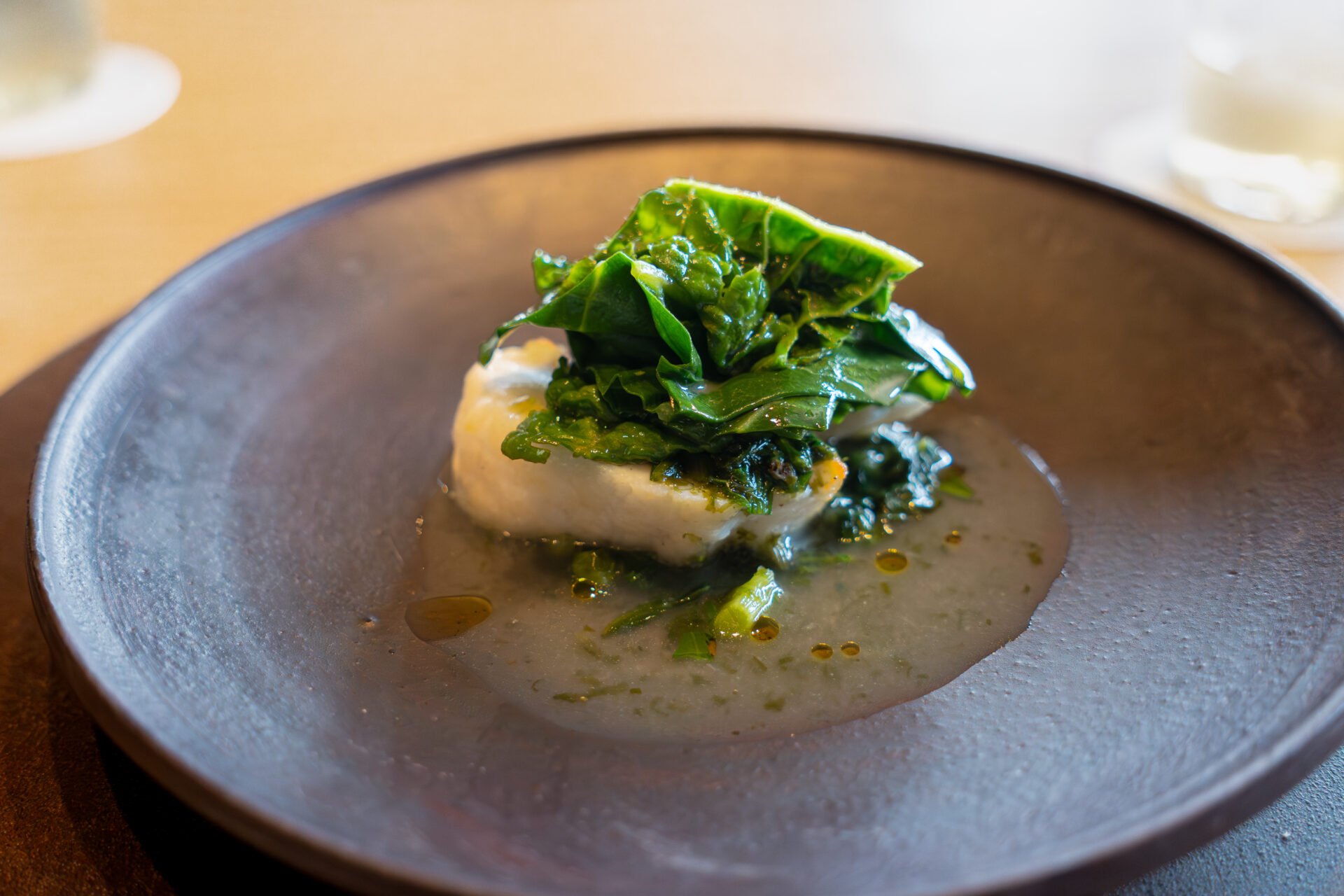
A refreshing house-made soda using syrup from kabosu, a citrus fruit native to Ōita Prefecture. Its crisp acidity and gentle sweetness paired perfectly with the meal, cleansing the palate with each effervescent sip without overwhelming the flavors of the food.
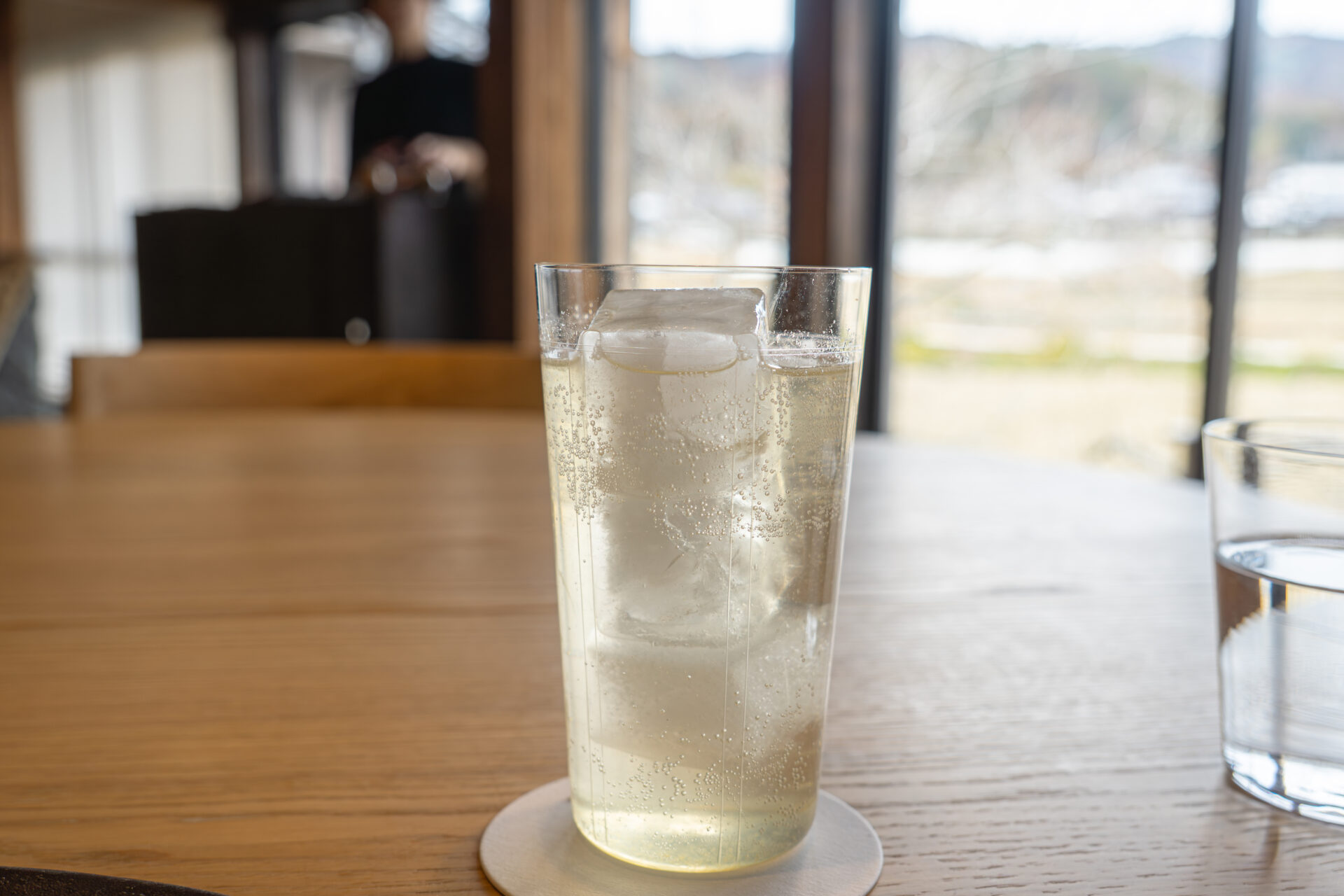
Venison / Burdock
A dish combining venison loin with venison consommé, wild oyster mushrooms, and burdock root.
The venison was tender and moist, with a refined yet wild character. Its flavor was enhanced by the earthy aroma of wild oyster mushrooms and the robust depth of burdock. A pour of venison consommé brought it all together, drawing out the full richness of the meat.
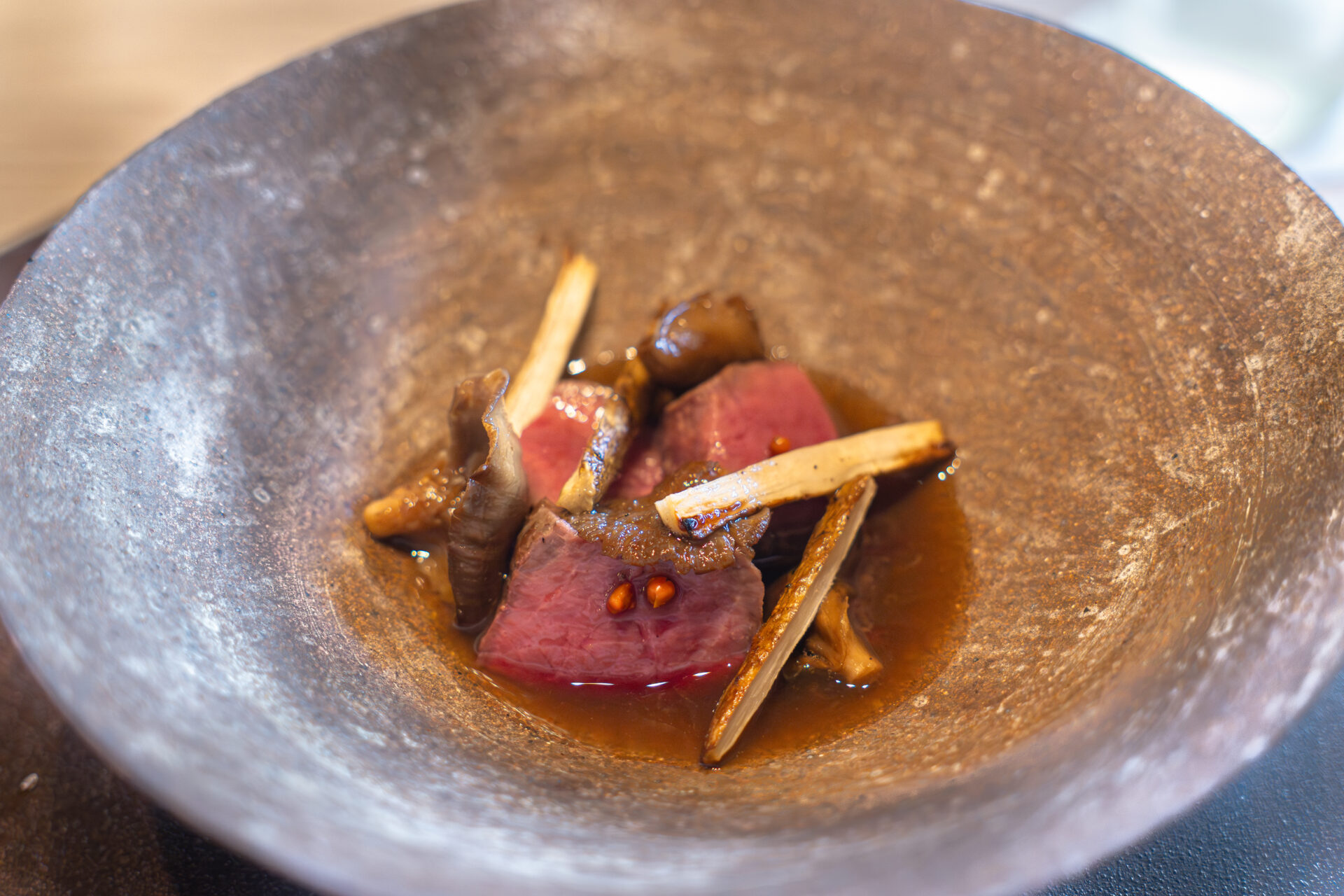
Wood Pigeon / Butterbur Sprouts
The main dish starred wood pigeon, known for its bold flavor.
One striking presentation featured pigeon gizzard skewered on a twig—an artistic touch that evoked a forest scene and added an element of surprise and playfulness to the course.
The sauce, made from pigeon stock and fuki no tō (butterbur sprouts), offered a deep umami balanced with a gentle bitterness. Accompanying sautéed Jerusalem artichoke and butterbur added a seasonal aroma and grounding texture.
A dish that celebrated the blessings of the forest—a multi-sensory experience that resonated deeply.
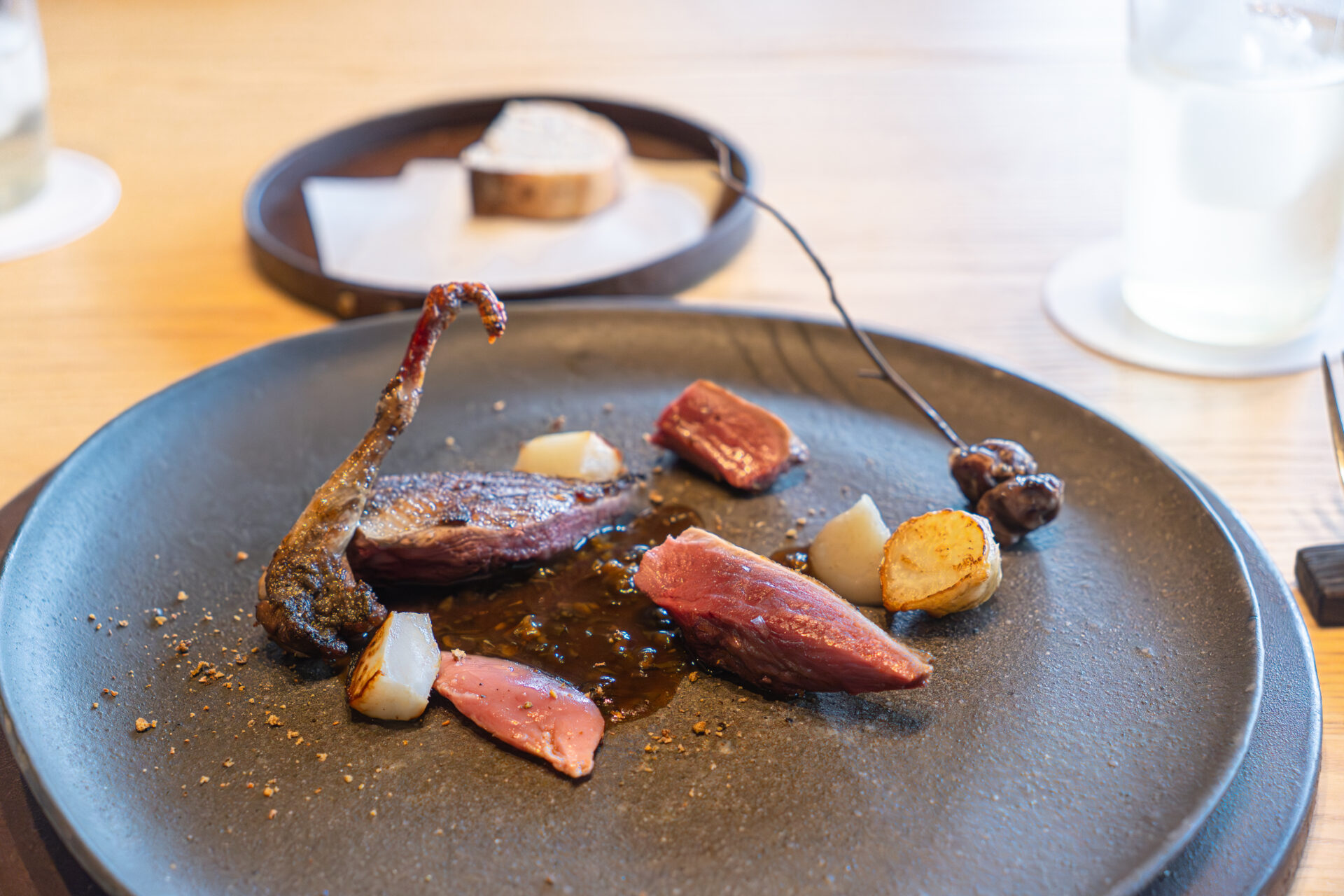
Dessert & Finale
Strawberry / Verbena
The dessert featured Beriitsu strawberries—an aromatic and sweet variety grown in Ōita Prefecture.
Their juicy freshness was complemented by the light tang of fromage blanc, resulting in a refreshing and refined flavor profile. Caramelized white chocolate added a gentle sweetness and a hint of toasty richness as an accent.
To finish, a scoop of ice cream infused with the fragrance of verbena brought the elements together. The herbal aroma lingered softly on the palate, leaving a clean and sophisticated impression.
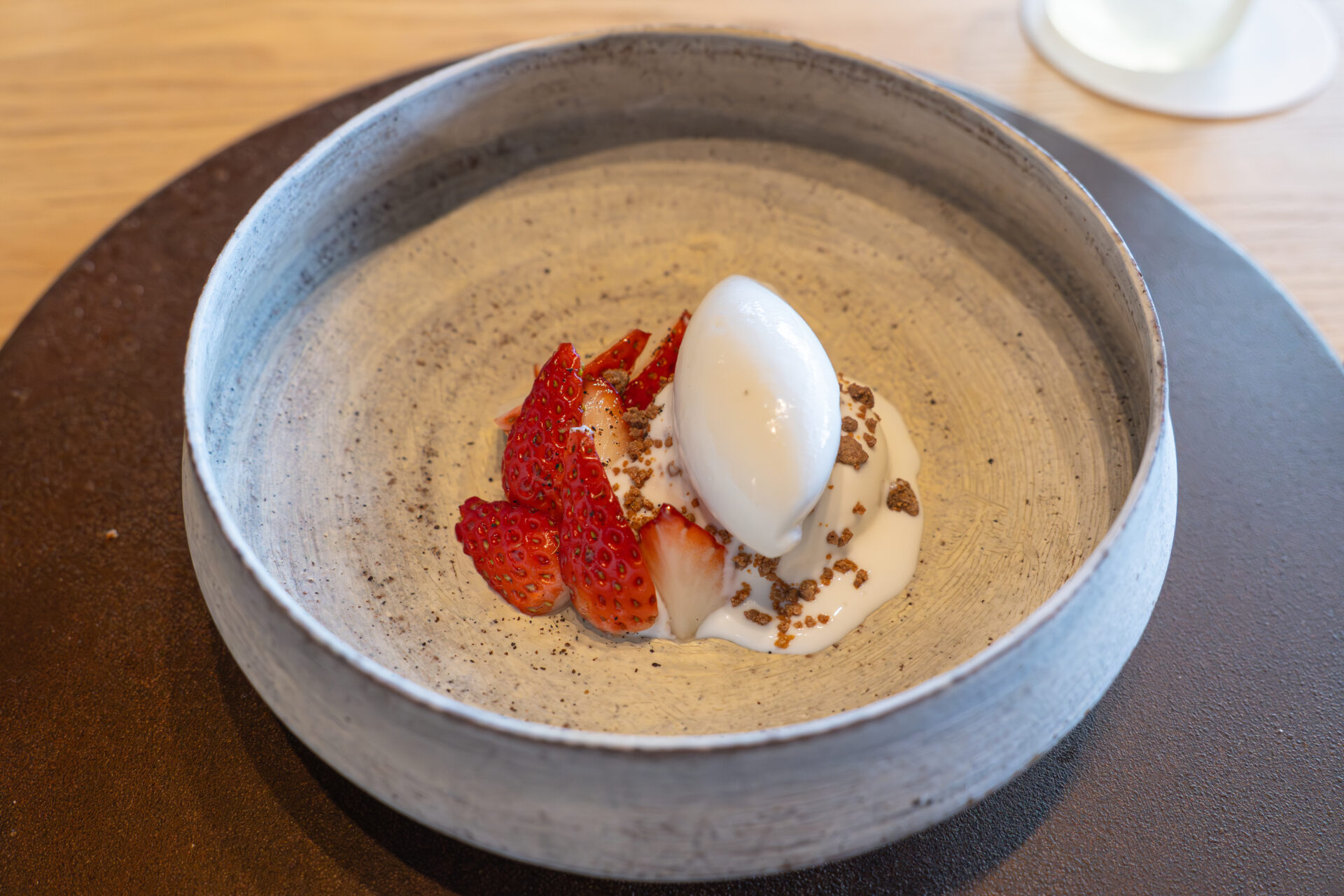
Petit Four
To close the meal, a classic French canelé was served.
Its crust was perfectly caramelized—crisp and golden—while the inside remained moist and chewy. The rich aroma of rum and the subtle sweetness of vanilla unfolded beautifully with each bite.
This elegant treat, crafted with techniques Chef Kawasaki refined in France, brought the experience to a graceful and memorable close.
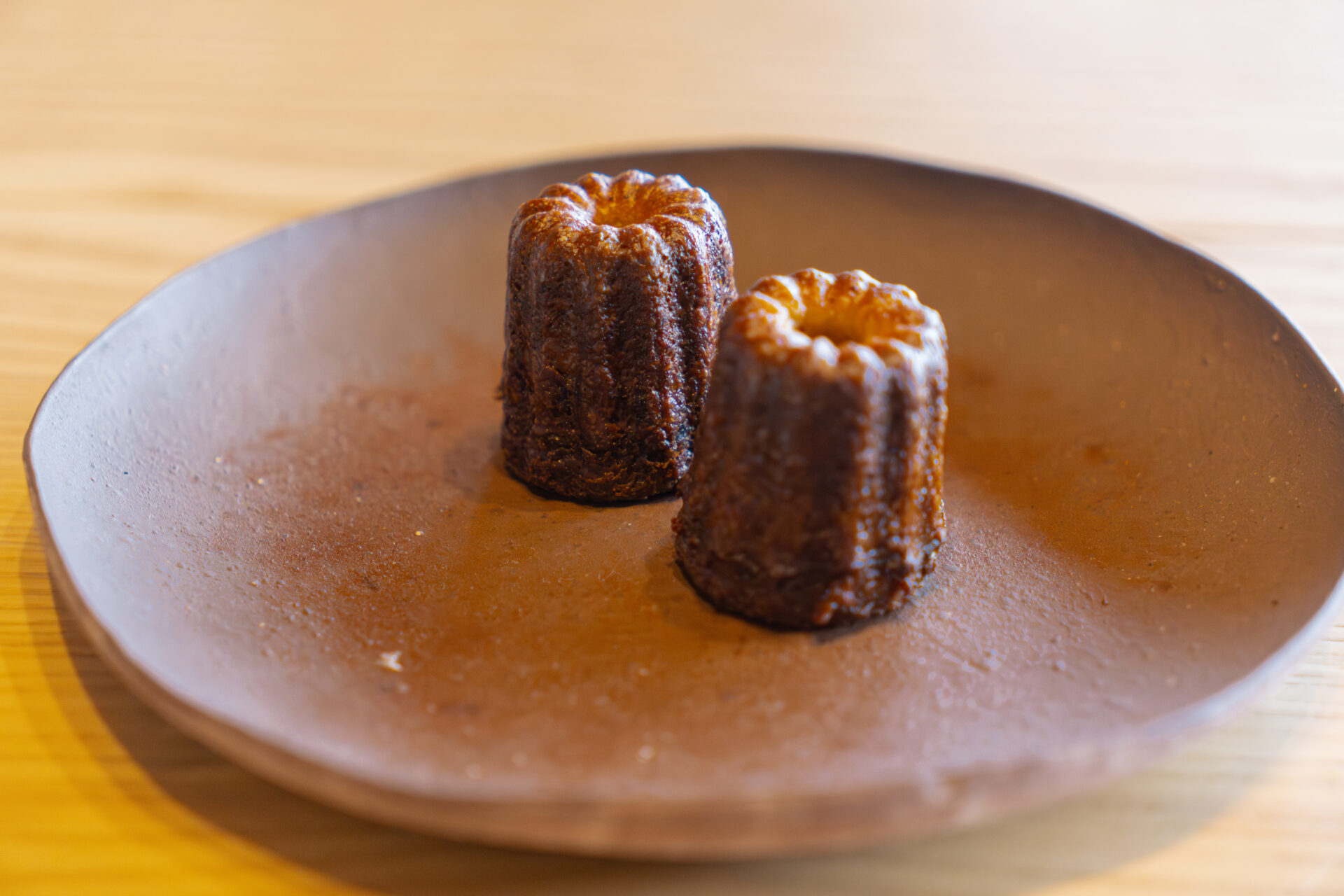
Outside the window, plum trees swayed in the breeze. Bulbuls gathered in the branches, pecking at leafy greens and plum fruits. While they can be troublesome to farmers, watching their plump bodies hopping about, one can’t help but jokingly muse, “They look kind of tasty.”
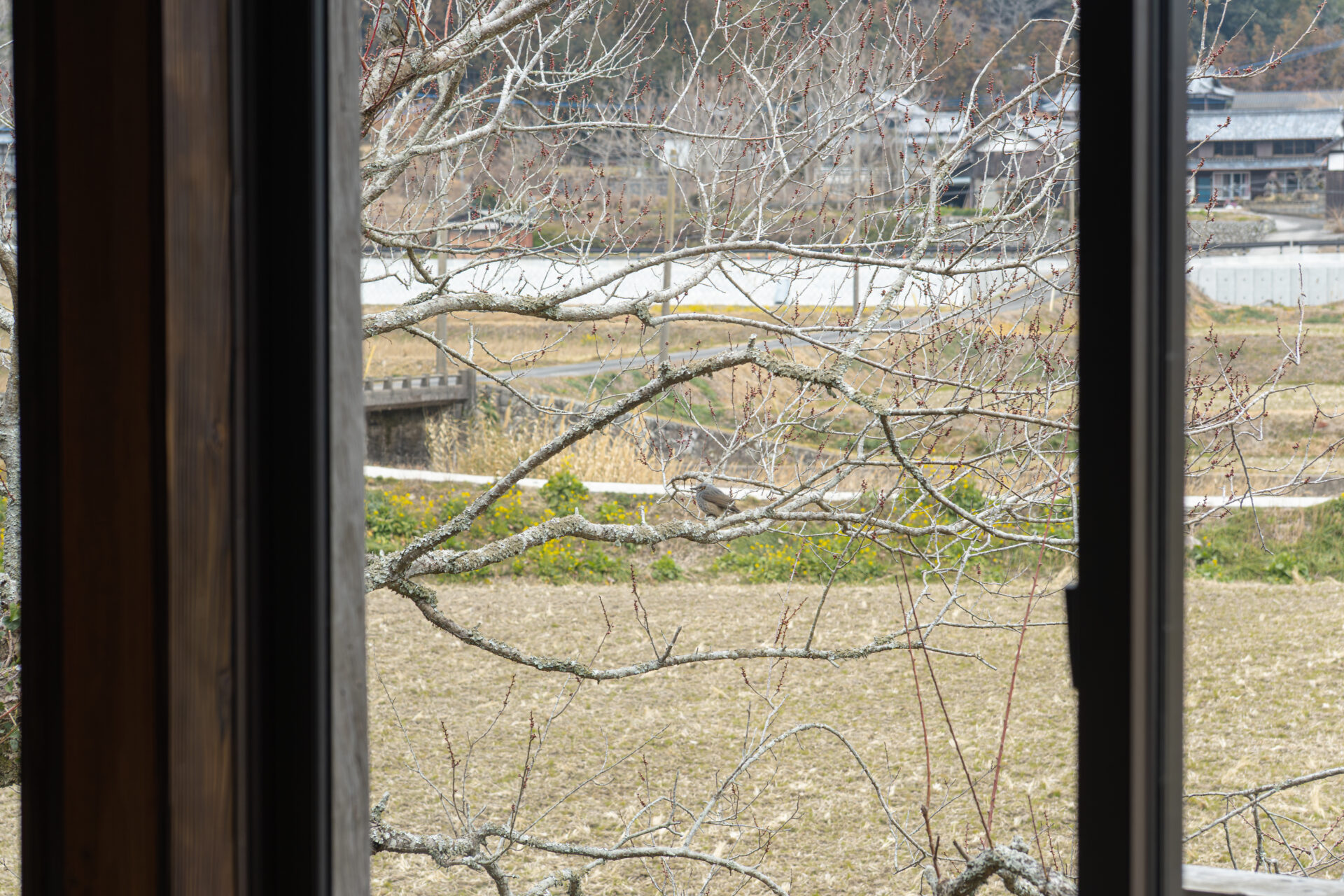
After the meal, I was shown to the guest room—an oasis of stillness deeply immersed in nature.
The interior featured earth-toned walls and warm wood accents in a minimalist design. Beyond the windows stretched a garden view, offering a constantly changing natural tableau. Time seemed to slow down as I relaxed into the space.
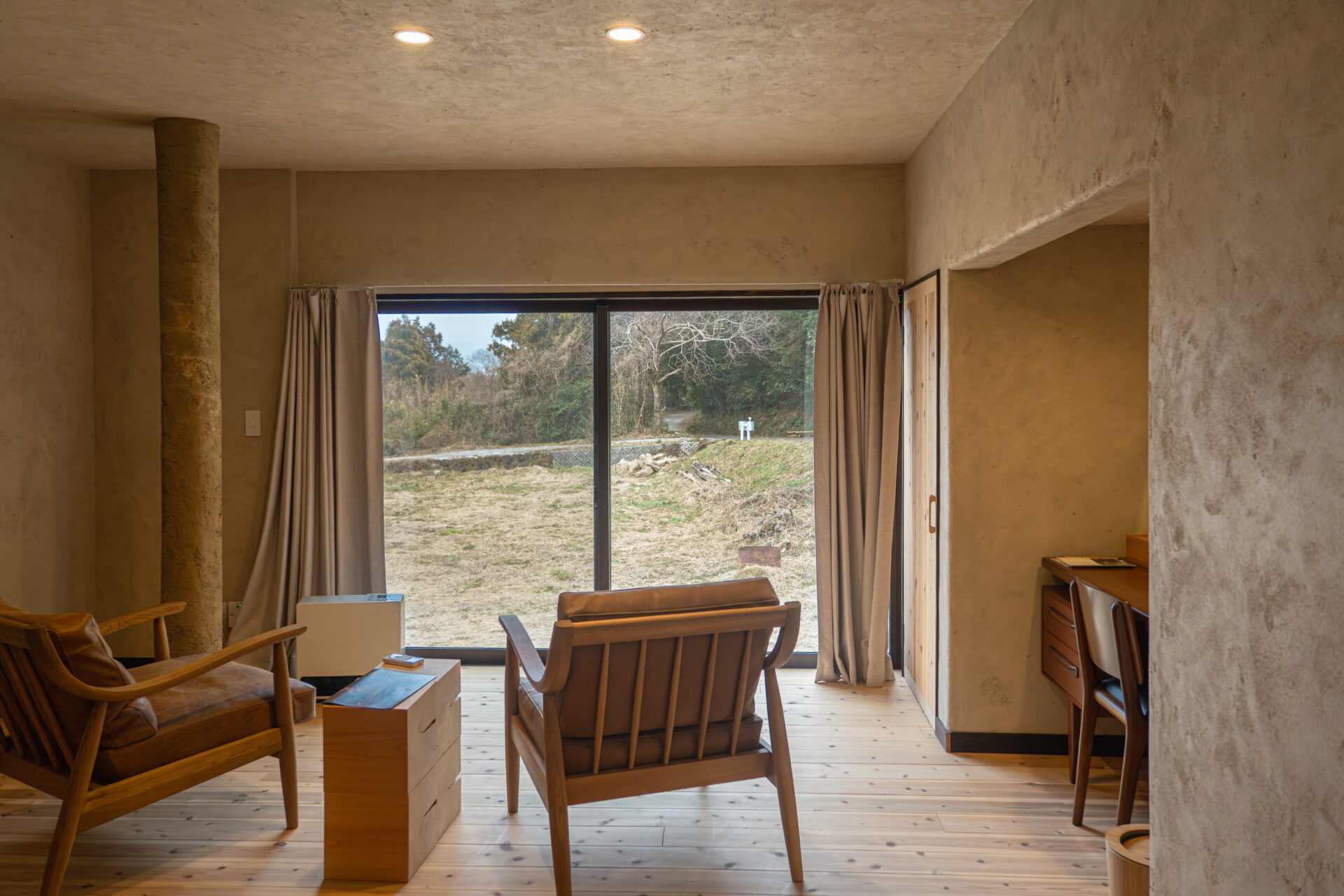
A highlight was the bathtub—crafted from smooth, clay-rich earth. Unlike typical sterile tubs, it radiated a natural warmth that gently embraced the body. Through large windows, natural light poured in and the outdoors unfolded before me, enhancing the feeling of calm and connection.
After a nourishing meal, I fell asleep in silence. The next morning, I awoke with the light of day. Time at physis is about leaving behind the noise of the city and fully living in tune with the rhythms of nature—a true experience of physis, “the inherent nature of things.”
This was a space that made such a vision easy to imagine.
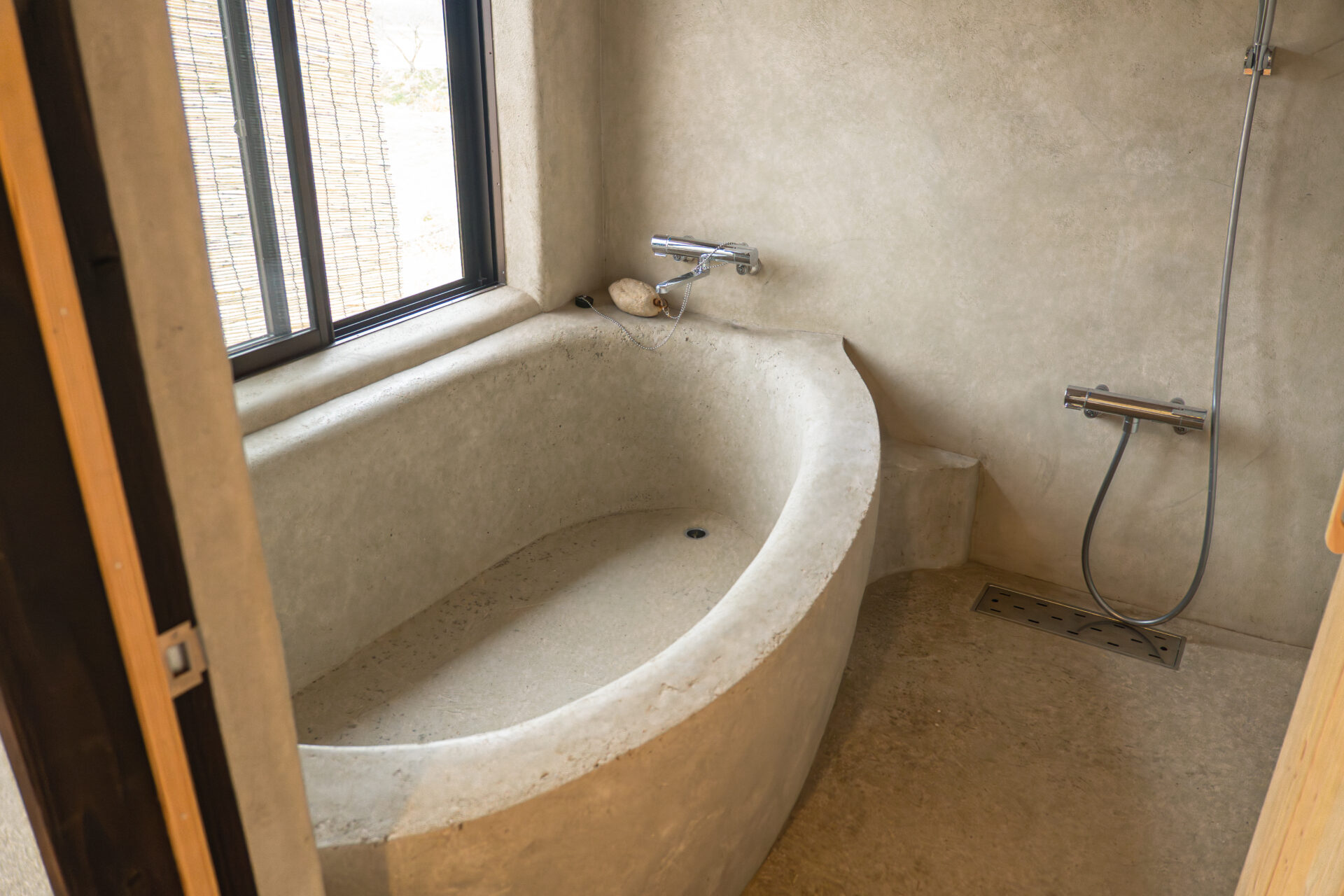
Reflections
physis is a truly special place where the concept of “the inherent nature of things” comes alive through both food and lodging.
The cuisine, crafted by Chef Kawasaki after years of training in France, highlights the natural bounty of Kunisaki and expresses it with refined technique. Each dish carried subtle layers of aroma and detail, drawing out both the strength and gentleness of the ingredients. The game dishes, in particular, reflected the richness of the land and the chef’s philosophy. His aspiration to one day cook game he’s hunted himself shows his deep-rooted connection to this place.
The auberge, set within a renovated 100-year-old kominka, exudes understated beauty, free of excessive ornamentation. Whether it was the earthen bath or the windows framing the natural scenery, every corner offered a sense of being immersed in nature.
Staying at physis wasn’t just about enjoying exquisite food—it was about quieting the senses and facing nature with intention. The cuisine, the space, and the landscape resonated in harmony, offering moments of serenity and richness rarely found in everyday life.
Time here didn’t shout—it quietly settled into the heart.
It’s a place I’d love to return to, and I look forward to seeing how it continues to evolve in the future.
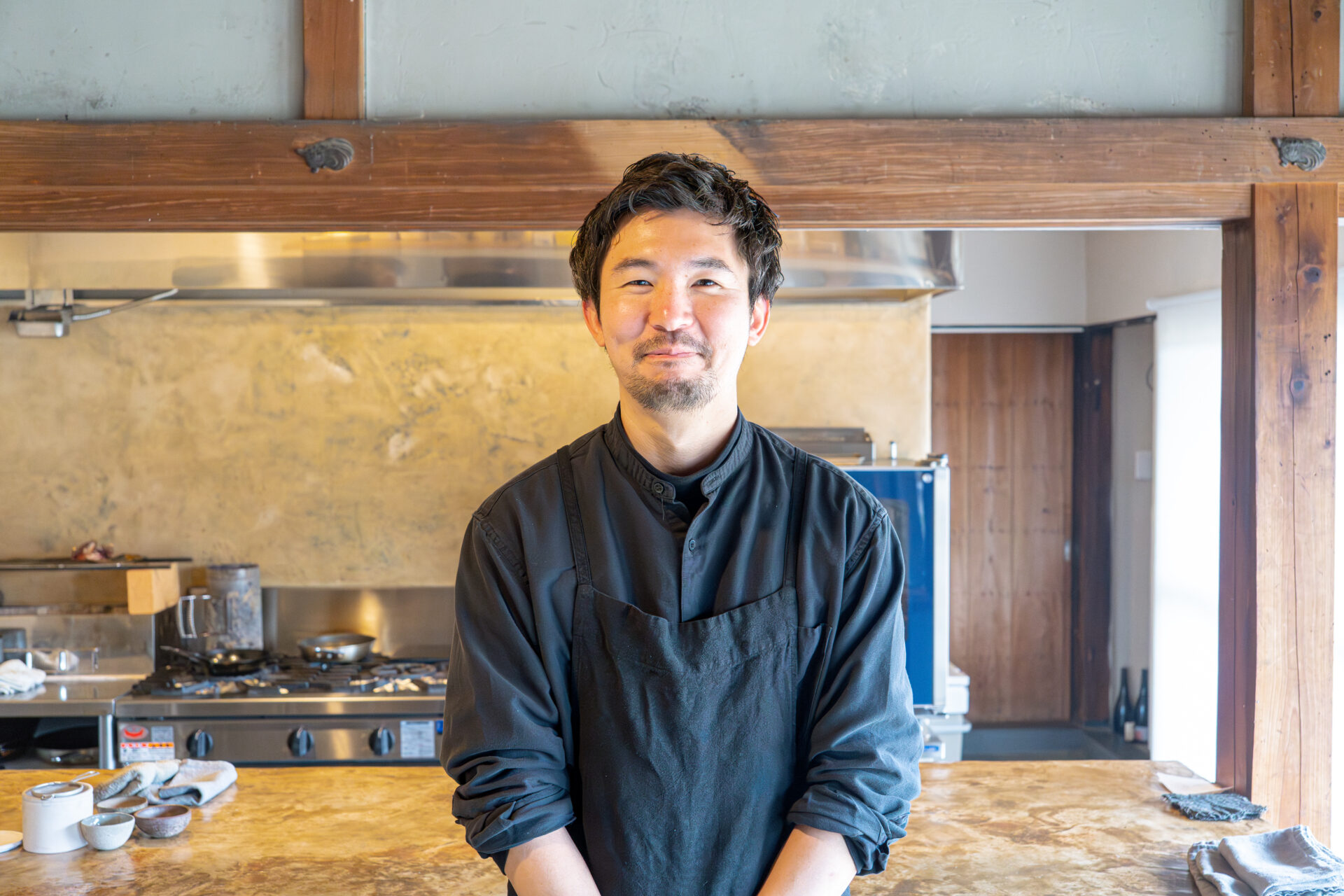
Reservations & Access
How to Book
Reservations at physis are by advance booking only and can be made via:
-
Phone
-
Direct Message (DM) on Instagram
Please note: all visits require a reservation in advance. Be sure to inquire ahead of time.
Access Information
Address:
470 Kunoura, Kunisaki-machi, Kunisaki City, Ōita Prefecture, Japan
For detailed access directions, please contact the restaurant directly when booking or refer to their official Instagram account.
- TAGS

